当代物流学习题2
- 格式:doc
- 大小:49.50 KB
- 文档页数:10
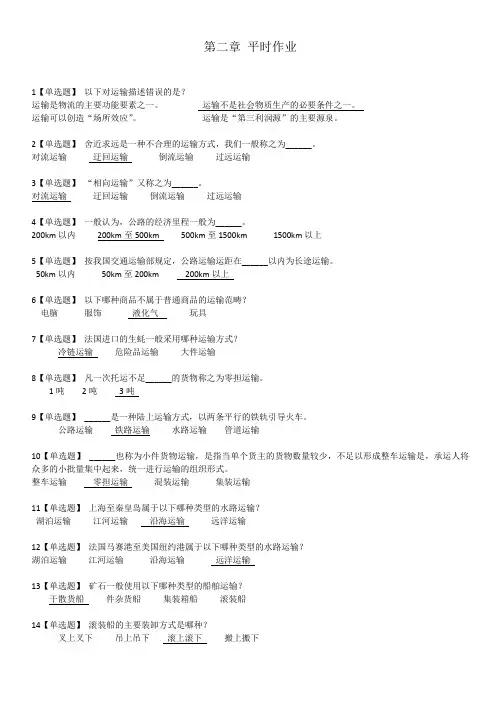
第二章平时作业1【单选题】以下对运输描述错误的是?运输是物流的主要功能要素之一。
运输不是社会物质生产的必要条件之一。
运输可以创造“场所效应”。
运输是“第三利润源”的主要源泉。
2【单选题】舍近求远是一种不合理的运输方式,我们一般称之为______。
对流运输迂回运输倒流运输过远运输3【单选题】“相向运输”又称之为______。
对流运输迂回运输倒流运输过远运输4【单选题】一般认为,公路的经济里程一般为______。
200km以内200km至500km 500km至1500km 1500km以上5【单选题】按我国交通运输部规定,公路运输运距在______以内为长途运输。
50km以内50km至200km 200km以上6【单选题】以下哪种商品不属于普通商品的运输范畴?电脑服饰液化气玩具7【单选题】法国进口的生蚝一般采用哪种运输方式?冷链运输危险品运输大件运输8【单选题】凡一次托运不足______的货物称之为零担运输。
1吨2吨3吨9【单选题】______是一种陆上运输方式,以两条平行的铁轨引导火车。
公路运输铁路运输水路运输管道运输10【单选题】______也称为小件货物运输,是指当单个货主的货物数量较少,不足以形成整车运输是,承运人将众多的小批量集中起来,统一进行运输的组织形式。
整车运输零担运输混装运输集装运输11【单选题】上海至秦皇岛属于以下哪种类型的水路运输?湖泊运输江河运输沿海运输远洋运输12【单选题】法国马赛港至美国纽约港属于以下哪种类型的水路运输?湖泊运输江河运输沿海运输远洋运输13【单选题】矿石一般使用以下哪种类型的船舶运输?干散货船件杂货船集装箱船滚装船14【单选题】滚装船的主要装卸方式是哪种?叉上叉下吊上吊下滚上滚下搬上搬下15【单选题】液态化工原料一般适用于以下哪种类型的集装箱?保温集装箱通用干货集装箱罐式集装箱干散货集装箱16【单选题】出口至美国的小家电一般适用于以下哪种类型的集装箱?保温集装箱通用干货集装箱罐式集装箱干散货集装箱17【单选题】以下哪种换算是正确的?40FT=1TEU 20FT=2TEU 40FT=2TEU 48FT=2.5TEU18【单选题】各类管材适用于以下哪种类型的货物集装?托盘集装箱集装袋集装货捆19【单选题】横宽2500mm的商品适用于以下哪种类型的集装箱?保温集装箱开顶集装箱框架集装箱罐式集装箱20【单选题】按照多式联运合同,以至少两种不同的运输方式,由多式联运经营人将货物从一国境内的接管地点运至另一国境内指定交付地点的货物运输组织方式,称为______。
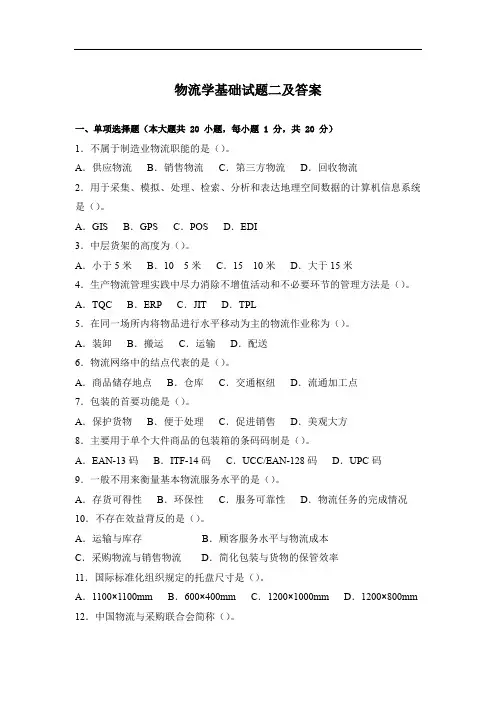
物流学基础试题二及答案一、单项选择题(本大题共 20 小题,每小题 1 分,共 20 分)1.不属于制造业物流职能的是()。
A.供应物流B.销售物流C.第三方物流D.回收物流2.用于采集、模拟、处理、检索、分析和表达地理空间数据的计算机信息系统是()。
A.GIS B.GPS C.POS D.EDI3.中层货架的高度为()。
A.小于5米B.105米C.1510米D.大于15米4.生产物流管理实践中尽力消除不增值活动和不必要环节的管理方法是()。
A.TQC B.ERP C.JIT D.TPL5.在同一场所内将物品进行水平移动为主的物流作业称为()。
A.装卸B.搬运C.运输D.配送6.物流网络中的结点代表的是()。
A.商品储存地点B.仓库C.交通枢纽D.流通加工点7.包装的首要功能是()。
A.保护货物B.便于处理C.促进销售D.美观大方8.主要用于单个大件商品的包装箱的条码码制是()。
A.EAN-13码B.ITF-14码C.UCC/EAN-128码D.UPC码9.一般不用来衡量基本物流服务水平的是()。
A.存货可得性B.环保性C.服务可靠性D.物流任务的完成情况10.不存在效益背反的是()。
A.运输与库存B.顾客服务水平与物流成本C.采购物流与销售物流D.简化包装与货物的保管效率11.国际标准化组织规定的托盘尺寸是()。
A.1100×1100mm B.600×400mm C.1200×1000mm D.1200×800mm 12.中国物流与采购联合会简称()。
A.CSCMP B.ELA C.CLA D.CFLP13.适合高价值、易腐变质和中长距离运输的是()。
A.公路运输B.铁路运输C.航空运输D.水路运输14.生产季节性商品的企业,为了协调旺季和淡季需求的不均匀性,通常采用在淡季生产储备一定数量的商品以调节旺季的巨大需求,这种储备克服了()。
A.所有权间隔B.场所间隔C.时间间隔D.使用权间隔15.不属于货物合并的作业模式是()。
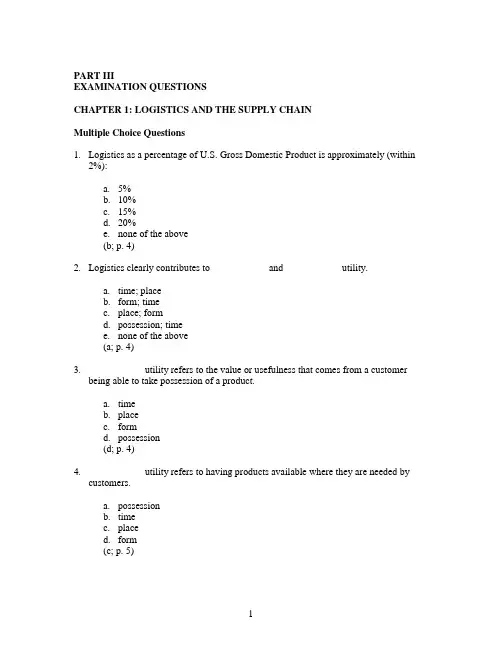
PART IIIEXAMINATION QUESTIONSCHAPTER 1: LOGISTICS AND THE SUPPLY CHAINMultiple Choice Questions1.Logistics as a percentage of U.S. Gross Domestic Product is approximately (within2%):a.5%b.10%c.15%d.20%e.none of the above(b; p. 4)2.Logistics clearly contributes to ___________ and ___________ utility.a.time; placeb.form; timec.place; formd.possession; timee.none of the above(a; p. 4)3.___________ utility refers to the value or usefulness that comes from a customerbeing able to take possession of a product.a.timeb.placec.formd.possession(d; p. 4)4.___________ utility refers to having products available where they are needed bycustomers.a.possessionb.timec.placed.form(c; p. 5)5.All of the following terms have been used to refer to business logistics except:a.business logisticsb.industrial distributionc.logistics managementd.physical distributione.all of the above are correct(e; p. 5)6.“How well a company does what it says it’s going to do” represents ___________.a.efficiencyb.productivityc.leading edge logisticsd.effectiveness(d; p. 6)7.Every customer getting the same type and levels of logistics service refers to___________.a.tailored logisticsb.mass logisticsc.effectivenessd.efficiency(b; p. 7)8.Which of the following is not a reason for the increased importance of logistics?a.growing power of manufacturersb.reduction in economic regulationc.globalization of traded.technological advances(a; pp. 8–10)9.What logistics “outsider” developed the concept of the value chain?a.Donald Bowersoxb.Gus Pagonisc.Michael Porterd.Michael Hammer(c; p. 8)10.The ___________ approach indicates that a company’s objectives can be realized byrecognizing the mutual interdependence of major functional areas.a.supply chainb.systemsc.interfunctionalityd.total cost(b; p. 10)11.The movement and storage of materials into a firm refers to:a.physical distributionb.materials managementc.materials handlingd.inbound logistics(d; p. 10)12.The movement and storage of materials within a firm refers to:a.physical distributionb.inbound logisticsc.materials managementd.procurement(c; p. 10)13.Logistics managers use the ___________ approach to coordinate inbound logistics,materials management, and physical distribution in a cost efficient manner.a.total costb.supply chainc.mass logisticsd.interfunctional(a; p. 11)14.A cost trade-off is a situation where:a.all costs react according to their individual degrees of inflation in the economyb.all costs are reflected as a percentage variation from standard costsc.some costs increase, some decrease, and the net effect is that total costsdecreased.some costs are eliminated by efficient management controls(c; p. 13)15.The cash flow associated with holding inventory is known as inventory ___________.a.turnoverb.valuationc.stockd.float(d; p. 14)16.__________ refers to one location where customers can purchase products from twoor more brand-name retailers.a.intensive distributionb.co-brandingc.co-generationd.selective distribution(b; p. 14)17.Phantom freight refers to:a.paying more for transportation than the actual costte shipmentsc.shipments accepted by non-certified carriersd.freight that “disappears” in transit(a; pp. 15–16)18.Freight absorption refers to:a. a special rate to cover increasing fuel costsb.rates that are higher than other carriers chargec.the ability of cardboard to absorb moistured.transportation payments lower than the actual costs incurred to ship theproduct(d; p. 16)nded costs refer to:a. a product that is shipped via surface transportb. a product that is quoted cost on delivery (COD)c. a prepaid shipmentd. a price that includes both the cost of the product plus transportation to thebuyer(d; p. 15)20.___________ is the excess freight bill paid by customers who live near the shippingpoint.a.freight absorptionb.delivered pricec.phantom freightnded price(c; p. 15)21.In FOB origin pricing, all of the following are true except:a.prices quoted do not include transportation to the consigneeb.marketers can adopt uniform prices on a regional or national basisc.consignees must arrange for the transportation of the purchased productd.the seller always receives the same net from each sale(b; p. 15)22.___________ refers to a situation where the applicable charges are paid at the time ashipment is tendered to a carrier.a.freight prepaidb.freight absorptionc.phantom freightd.FOB origin(a; p. 16)23.___________ refers to charges being paid at the time of shipment delivery.a.freight absorptionb.freight yieldc.freight collectd.FOB destination(c; p. 16)24.The four basic components of the marketing mix include all of the following except:a.priceb.productionc.productd.place(b; p. 14)25.The most common interface between production and logistics generally involves:a.the use of plastic versus wood palletsb.the mode of transportationc.shipment pricingd.the length of production runs(d; p. 18)26.___________ refers to the delay of value-added activities such as assembly,production, and packaging to the latest possible time.a.building blocksb.deferralc.demurraged.postponement(d; p. 19)27.The ownership channel consists of all parties except:a.customersb.manufacturersc.wholesalersd.retailers(a; p. 19)28.The ____________ channel handles the physical flow of product.a.ownershipb.negotiationsc.logisticsd.promotions(c; p. 19)29.Which channel covers the movement of title to the goods?a.promotionsb.logisticsc.financed.ownership(d; p. 21)30.Which of the following is not part of the marketing channel?a.the logistics channelb.the negotiations channelc.the promotion channeld.the finance channele.all are part of the marketing channel(e; p. 19)31.Channel intermediaries:a.assume temporary ownership of the goodsb.fill nichesc.disappear as the market becomes organizedd.tend to lack focus(b; p. 24)32.Intermediaries in the marketing channel perform all of the following functions except:a.supply informationb.match buyers and sellersc.assume temporary ownership of the goodsd.develop and fill niches(c; pp. 23–24)33.The most costly logistics activity in many firms is ____________.a.industrial packagingb.warehousing managementc.order managementd.transportation management(d; p. 27)34.____________ is bringing together similar stocks from different sources.a.accumulatingb.assortingc.auditingd.allocating(a; p. 23)35.____________ refers to breaking a homogenous supply into smaller lots.a.sorting outb.allocatingc.accumulatingd.assorting(b; p. 23)True-False Questions1.Absolute and relative logistics costs in relation to Gross Domestic Product vary fromcountry to country. (True; p. 4)2.Logistics clearly contributes to time and form utility. (False; p. 4)3.The current definition of logistics, as promulgated by the Council of LogisticsManagement, suggests that logistics is part of the supply chain process. (True; p. 6)4.The purpose of logistics is to maximize customer service. (False; p. 7)5.Logistical principles apply only to for-profit organizations. (False; p. 7)6.Two of the five primary activities in the value chain are inbound logistics andoutbound logistics. (True; pp. 8–9)7.The key aspect of the total cost approach is to maximize customer satisfaction. (False;p. 13)8.The Internet has done little to improve logistical effectiveness and efficiency. (False;p. 9)9.Stock-keeping units (SKUs) are the same as line items of inventory. (True; p.10)10.Inbound logistics refers to the movement and storage of materials into a firm. (True; p.10)11.Inbound logistics is synonymous with materials management. (False; p. 10)12.Interfunctional logistics attempts to coordinate inbound logistics, materials manage-ment, and physical distribution in a cost efficient manner that supports anorganization’s customer service objectives. (False; p. 10)mon sense is one of the keys to being an effective logistics manager. (True; p.11)14.The key to the total cost approach is that all relevant cost items are consideredsimultaneously when making a decision. (True; p. 13)15.Logistics offers many companies an important route for creating marketingsuperiority. (True; p.14)16.Co-branding is a retailing strategy that is associated with place decisions. (True; p. 14)17.As a general rule, marketers prefer FOB origin pricing rather than FOB destinationpricing. (False; pp. 15–16)18.Phantom freight and freight absorption are associated with FOB origin pricing. (False;pp. 15–16)19.It is better for a logistics manager to be a generalist rather than a specialist. (False; p.27)20.Stockouts refer to a situation where a company is out of an item at the same time thatthere is demand for that item. (True; p. 18)21.Long production runs sometimes result in excessive inventory of products withlimited demand for them. (True; p. 18)22.Intermediaries assume ownership of goods while the y’re in the marketing channel.(False; p. 24)23.Channel members are usually more concerned about sellers’ needs than with buyers’needs. (False; p. 20)24.The negotiations channel is the one where buy and sell agreements are reached. (True;p. 21)25.There is no linkage between the promotions and logistics channel. (False; pp. 22–23)26.The most significant contribution that the logistics channel makes to the overallchannel process is the sorting function. (True; p. 23)27.The sorting function has four steps. (True; p. 23)28.The sorting function takes place between retailers and the consumer. (False; p. 23)29.A broker is a type of intermediary often associated with the negotiations channel.(True; p 24.)30.In channel negotiations, all parties are presumed to have equal bargaining strength.(False; pp. 20-21)31.Freight forwarders are the most common intermediary in the logistics channel. (True;p. 24)32.Returned products represent one type of activity in the logistical channel. (True; p. 27)33.The key to total cost analysis is to make sure that either transportation or inventorycosts are minimized. (False; p. 13)34.There are relatively few opportunities for employment in the logistics sector. (False; p.27)35.The logistics channel is the most important of the marketing channels. (False; p. 19)。
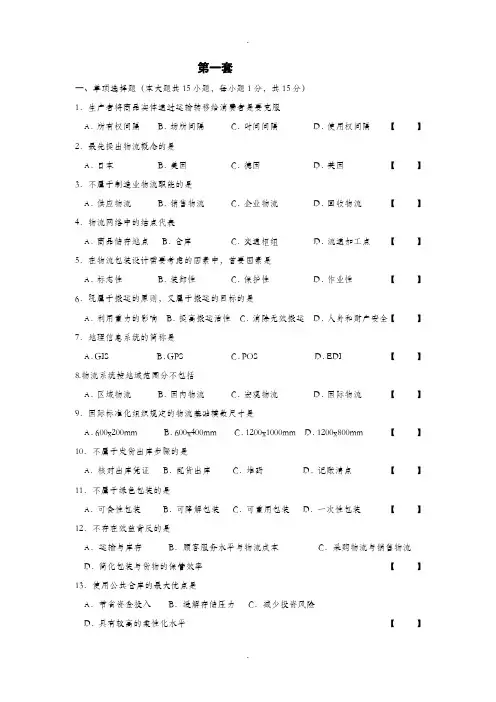
第一套一、单项选择题(本大题共15小题,每小题1分,共15分)1.生产者将商品实体通过运输转移给消费者是要克服A.所有权间隔B.场所间隔C.时间间隔D.使用权间隔【】2.最先提出物流概念的是A.日本B.美国C.德国D.英国【】3.不属于制造业物流职能的是A.供应物流B.销售物流C.企业物流D.回收物流【】4.物流网络中的结点代表A.商品储存地点B.仓库C.交通枢纽D.流通加工点【】5.在物流包装设计需要考虑的因素中,首要因素是A.标志性B.装卸性C.保护性D.作业性【】6.既属于搬运的原则,又属于搬运的目标的是A.利用重力的影响B.提高搬运活性C.消除无效搬运D.人身和财产安全【】7.地理信息系统的简称是A.GIS B.GPS C.POS D.EDI 【】8.物流系统按地域范围分不包括A.区域物流B.国内物流C.宏观物流D.国际物流【】9.国际标准化组织规定的物流基础模数尺寸是A.600x200mm B.600x400mm C.1200x1000mm D.1200x800mm 【】10.不属于发货出库步骤的是A.核对出库凭证B.配货出库C.堆码D.记账清点【】11.不属于绿色包装的是A.可食性包装B.可降解包装C.可重用包装D.一次性包装【】12.不存在效益背反的是A.运输与库存B.顾客服务水平与物流成本C.采购物流与销售物流D.简化包装与货物的保管效率【】13.使用公共仓库的最大优点是A.节省资金投入B.缓解存储压力C.减少投资风险D.具有较高的柔性化水平【】14.生产物流管理实践中尽力消除不增值活动和不必要环节的管理方法是A.TQC B.MRP C.JIT D.BPR 【】15.不属于衡量企业物流质量的主要因素的是A.物流时间B.物流成本C.物流效率D.物流网络【】一、多项选择题(本大题共5小题,每小题3分,共15分)16.目前国际上通用的和公认的物流条码码制有A.ITF-14 B.UCC/EAN-128 C.EAN-8D.ITF-13 E.EAN-13 【】17.人类社会生产与再生产的总过程分为A.生产B.分配C.交换D.消费E.物流【】18.基本物流服务主要包括A.运输B.保管C.包装D.装卸E.流通加工【】19.影响运输成本的因素包括A.距离B.装载量C.产品密度D.责任E.风险【】20.构成EDI系统的要素包括A.软件B.硬件C.通信网络D.数据标准化E.计算机人员【】二、名词解释题(本大题共5小题,每小题4分,共20分)21.物流22.配送中心23.搬运活性24.第三方物流25.流通加工三、简答题(本大题共5小题,每小题7分,共35分)26.什么是物流系统的效益背反?27.什么是物流冰山说?28.公路运输的特点是什么?29.不合理的储存现象有哪些?30.流通加工与生产加工有什么区别?四、论述题(本大题共1小题,每小题15分,共15分)31.请阐述物流服务与物流成本之间的关系,以及如何进行决策。
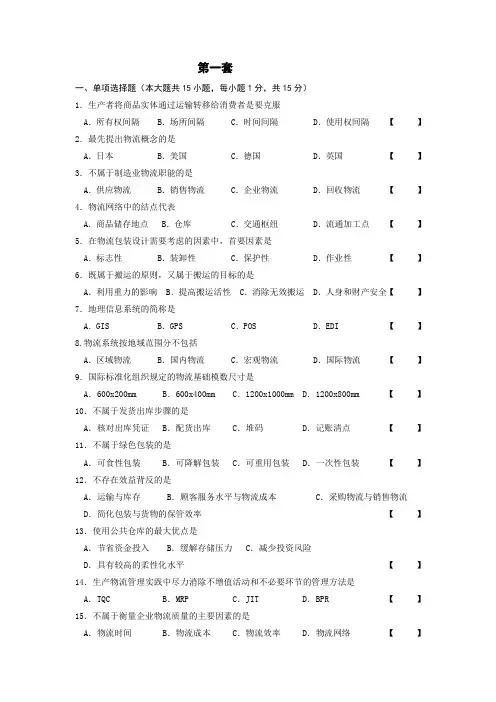
第一套一、单项选择题(本大题共15小题,每小题1分,共15分)1.生产者将商品实体通过运输转移给消费者是要克服A.所有权间隔 B.场所间隔 C.时间间隔 D.使用权间隔【】2.最先提出物流概念的是A.日本 B.美国 C.德国 D.英国【】3.不属于制造业物流职能的是A.供应物流 B.销售物流 C.企业物流 D.回收物流【】4.物流网络中的结点代表A.商品储存地点 B.仓库 C.交通枢纽 D.流通加工点【】5.在物流包装设计需要考虑的因素中,首要因素是A.标志性 B.装卸性 C.保护性 D.作业性【】6.既属于搬运的原则,又属于搬运的目标的是A.利用重力的影响 B.提高搬运活性 C.消除无效搬运 D.人身和财产安全【】7.地理信息系统的简称是A.GIS B.GPS C.POS D.EDI 【】8.物流系统按地域范围分不包括A.区域物流 B.国内物流 C.宏观物流 D.国际物流【】9.国际标准化组织规定的物流基础模数尺寸是A.600x200mm B.600x400mm C.1200x1000mm D.1200x800mm 【】10.不属于发货出库步骤的是A.核对出库凭证 B.配货出库 C.堆码 D.记账清点【】11.不属于绿色包装的是A.可食性包装 B.可降解包装 C.可重用包装 D.一次性包装【】12.不存在效益背反的是A.运输与库存 B.顾客服务水平与物流成本 C.采购物流与销售物流D.简化包装与货物的保管效率【】13.使用公共仓库的最大优点是A.节省资金投入 B.缓解存储压力 C.减少投资风险D.具有较高的柔性化水平【】14.生产物流管理实践中尽力消除不增值活动和不必要环节的管理方法是A.TQC B.MRP C.JIT D.BPR 【】15.不属于衡量企业物流质量的主要因素的是A.物流时间 B.物流成本 C.物流效率 D.物流网络【】一、多项选择题(本大题共5小题,每小题3分,共15分)16.目前国际上通用的和公认的物流条码码制有A.ITF-14 B.UCC/EAN-128 C.EAN-8D.ITF-13 E.EAN-13 【】17.人类社会生产与再生产的总过程分为A.生产 B.分配 C.交换D.消费 E.物流【】18.基本物流服务主要包括A.运输 B.保管 C.包装D.装卸 E.流通加工【】19.影响运输成本的因素包括A.距离 B.装载量 C.产品密度D.责任 E.风险【】20.构成EDI系统的要素包括A.软件 B.硬件 C.通信网络D.数据标准化 E.计算机人员【】二、名词解释题(本大题共5小题,每小题4分,共20分)21.物流22.配送中心23.搬运活性24.第三方物流25.流通加工三、简答题(本大题共5小题,每小题7分,共35分)26.什么是物流系统的效益背反?27.什么是物流冰山说?28.公路运输的特点是什么?29.不合理的储存现象有哪些?30.流通加工与生产加工有什么区别?四、论述题(本大题共1小题,每小题15分,共15分)31.请阐述物流服务与物流成本之间的关系,以及如何进行决策。
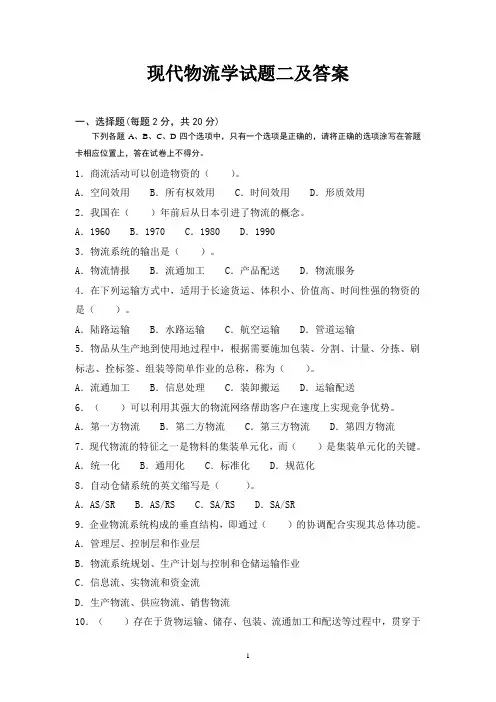
现代物流学试题二及答案一、选择题(每题2分,共20分)下列各题A、B、C、D四个选项中,只有一个选项是正确的,请将正确的选项涂写在答题卡相应位置上,答在试卷上不得分。
1.商流活动可以创造物资的()。
A.空间效用 B.所有权效用 C.时间效用 D.形质效用2.我国在()年前后从日本引进了物流的概念。
A.1960 B.1970 C.1980 D.19903.物流系统的输出是()。
A.物流情报 B.流通加工 C.产品配送 D.物流服务4.在下列运输方式中,适用于长途货运、体积小、价值高、时间性强的物资的是()。
A.陆路运输 B.水路运输 C.航空运输 D.管道运输5.物品从生产地到使用地过程中,根据需要施加包装、分割、计量、分拣、刷标志、拴标签、组装等简单作业的总称,称为()。
A.流通加工 B.信息处理 C.装卸搬运 D.运输配送6.()可以利用其强大的物流网络帮助客户在速度上实现竞争优势。
A.第一方物流 B.第二方物流 C.第三方物流 D.第四方物流7.现代物流的特征之一是物料的集装单元化,而()是集装单元化的关键。
A.统一化 B.通用化 C.标准化 D.规范化8.自动仓储系统的英文缩写是()。
A.AS/SR B.AS/RS C.SA/RS D.SA/SR9.企业物流系统构成的垂直结构,即通过()的协调配合实现其总体功能。
A.管理层、控制层和作业层B.物流系统规划、生产计划与控制和仓储运输作业C.信息流、实物流和资金流D.生产物流、供应物流、销售物流10.()存在于货物运输、储存、包装、流通加工和配送等过程中,贯穿于物流作业的始末。
其工作的好坏,直接影响到物流系统的效率、效益和效用。
A.仓储技术及设备 B.物流技术及其装备C.装卸搬运技术装备 D.自动化仓储系统二、简答题(每题5分,共40分)1.商流与物流的关系如何?2.物流系统的构成要素包括哪些?3.简要叙述物流质量管理的特点及内容。
4.物流信息的特点是什么?物流信息系统的功能有哪些?5.简述城市物流的定义与城市物流系统的构成。
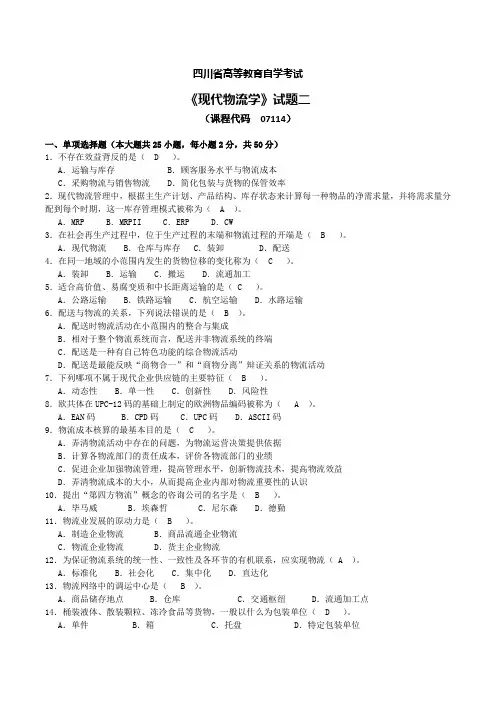
四川省高等教育自学考试《现代物流学》试题二(课程代码07114)一、单项选择题(本大题共25小题,每小题2分,共50分)1.不存在效益背反的是( D )。
A.运输与库存 B.顾客服务水平与物流成本C.采购物流与销售物流 D.简化包装与货物的保管效率2.现代物流管理中,根据主生产计划、产品结构、库存状态来计算每一种物品的净需求量,并将需求量分配到每个时期,这一库存管理模式被称为( A )。
A.MRP B.MRPII C.ERP D.CW3.在社会再生产过程中,位于生产过程的末端和物流过程的开端是( B )。
A.现代物流 B.仓库与库存 C.装卸 D.配送4.在同一地域的小范围内发生的货物位移的变化称为( C )。
A.装卸 B.运输 C.搬运 D.流通加工5.适合高价值、易腐变质和中长距离运输的是( C )。
A.公路运输 B.铁路运输 C.航空运输 D.水路运输6.配送与物流的关系,下列说法错误的是( B )。
A.配送时物流活动在小范围内的整合与集成B.相对于整个物流系统而言,配送并非物流系统的终端C.配送是一种有自己特色功能的综合物流活动D.配送是最能反映“商物合一”和“商物分离”辩证关系的物流活动7.下列哪项不属于现代企业供应链的主要特征( B )。
A.动态性 B.单一性 C.创新性 D.风险性8.欧共体在UPC-12码的基础上制定的欧洲物品编码被称为( A )。
A.EAN码 B.CPD码 C.UPC码 D.ASCII码9.物流成本核算的最基本目的是( C )。
A.弄清物流活动中存在的问题,为物流运营决策提供依据B.计算各物流部门的责任成本,评价各物流部门的业绩C.促进企业加强物流管理,提高管理水平,创新物流技术,提高物流效益D.弄清物流成本的大小,从而提高企业内部对物流重要性的认识10.提出“第四方物流”概念的咨询公司的名字是( B )。
A.毕马威 B.埃森哲 C.尼尔森 D.德勤11.物流业发展的原动力是( B )。
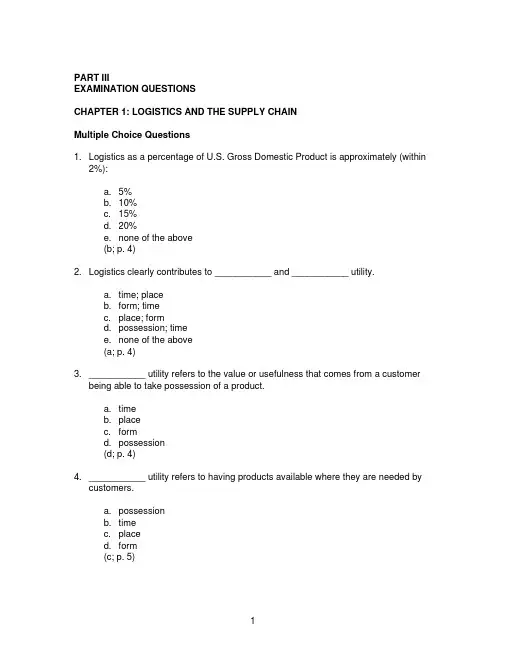
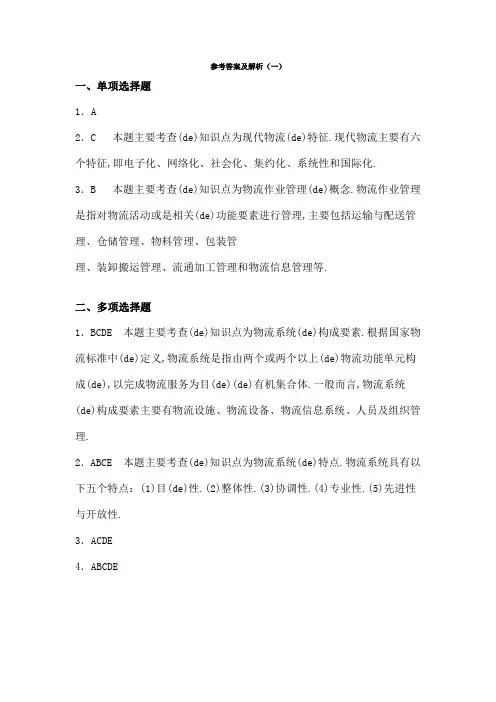
参考答案及解析(一)一、单项选择题1.A2.C 本题主要考查(de)知识点为现代物流(de)特征.现代物流主要有六个特征,即电子化、网络化、社会化、集约化、系统性和国际化.3.B 本题主要考查(de)知识点为物流作业管理(de)概念.物流作业管理是指对物流活动或是相关(de)功能要素进行管理,主要包括运输与配送管理、仓储管理、物料管理、包装管理、装卸搬运管理、流通加工管理和物流信息管理等.二、多项选择题1.BCDE 本题主要考查(de)知识点为物流系统(de)构成要素.根据国家物流标准中(de)定义,物流系统是指由两个或两个以上(de)物流功能单元构成(de),以完成物流服务为目(de)(de)有机集合体.一般而言,物流系统(de)构成要素主要有物流设施、物流设备、物流信息系统、人员及组织管理.2.ABCE 本题主要考查(de)知识点为物流系统(de)特点.物流系统具有以下五个特点:(1)目(de)性.(2)整体性.(3)协调性.(4)专业性.(5)先进性与开放性.3.ACDE4.ABCDE5.BCE本题主要考查(de)知识点为物流标准化(de)特点.物流标准化有以下六个特点:(1)复杂性.(2)固有性.(3)科学性.(4)民主性.(5)经济性.(6)国际性.参考答案及解析(二)一、单项选择题1.A2.D3.B 本题主要考查(de)知识点为仓库管理(de)质量第一原则.物资保管(de)根本目(de)就是要保持物资原有(de)使用价值和价值,以优质物资满足企业(de)生产需要.所以,物资保管必须要将物资保管(de)质量放在第一位,保证库存物资质量良好、数量正确、配套齐全、账物相符.4.C 本题主要考查(de)知识点为经常库存(de)概念.经常库存是指企业在正常(de)经营环境下为了满足日常所需而建立(de)库存.仓库一般通过经常库存来保证一定时期(de)供应能力,这种库存随着陆续(de)出库需要而不断地减少,当库存降低到某一水平时,就要通过订货来补充库存.此外,经常库存(de)高低与库存补充(de)采购也有着密切(de)联系.5.A 本题主要考查(de)知识点为仓库生产管理(de)内容.仓库生产管理,即仓库作业过程管理,仓库规划管理,物品(de)收、发、保管,以及物品(de)搬运作业管理等.二、多项选择题1.BC 本题主要考查(de)知识点为仓库根据保管形态(de)分类.根据保管形态,可将仓库分为普通仓库、保温仓库、特种仓库和水上仓库四种. 2.ABDE 本题主要考查(de)知识点为仓库管理原则.为了能够以较少(de)劳动消耗来高质量地完成物资(de)保管工作,在仓库管理(de)实际工作中应遵循以下基本原则:(1)质量第一.(2)预防为主.(3)讲究科学.(4)提高效率.(5)确保安全.3.ABD4.ACE 本题主要考查(de)知识点为库存按照经营过程(de)角度(de)分类.按照经营过程(de)角度分类,库存可分为:(1)经常库存.(2)在途库存.(3)安全库存.(4)投机库存.(5)季节性库存.(6)促销库存.(7)呆滞库存.5.ABC 本题主要考查(de)知识点为协同供应体系下(de)库存管理模式.协同供应体系下(de)库存管理模式,主要是通过共同管理业务过程及共享信息来改善用户与供应商(de)伙伴关系,提高预测(de)精准度,最终达到提高供应效率、降低库存和提高用户满意度(de)目(de).协同供应体系下(de)库存管理模式,主要有及时供应、供应商寄售、保全库和虚拟库存等多种形式.参考答案及解析(三)一、单项选择题1.B2. D3. A 本题主要考查(de)知识点为防震包装(de)概念.防震包装又被称作为缓冲包装,是指为了减缓内装物受到冲击和振动,保护其免受损坏所采取(de)一定防护措施(de)包装.防震包装主要有以下三种方法:(1)全面防震包装方法.(2)部分防震包装方法.(3)悬浮式防震包装方法.4. B 本题主要考查(de)知识点为木板箱(de)特点.从保护功能方面来看,木板箱具备较高(de)抗戳穿强度和抗压强度,可以较好地抵抗外物碰撞,承受较高(de)堆垛负荷,尤其是在受潮(de)情况下,不会由于强度下降而变形导致倒垛事故.二、多项选择题1. ABDE 本题主要考查(de)知识点为产品包装基本原则.产品包装基本原则包括适用原则、美观原则、可靠原则、经济原则和科学原则.2. ADE 本题主要考查(de)知识点为现代物流包装容器(de)主要类型.现代物流包装容器(de)主要类型有:(1)瓦楞纸箱.(2)木箱.(3)托盘.(4)集装箱.(5)塑料周转箱.3. AB 本题主要考查(de)知识点为真空包装法(de)别称.真空包装法又称作减压包装法或是排气包装法.这种包装能够阻挡外界(de)水汽进入包装容器内,也可以防止在密闭(de)防潮包装内部存有潮湿空气,在气温下降(de)时候结露.选项C、D、E是防震包装(de)三种方法.4. BCE参考答案及解析(四)一、单项选择题1. D 本题主要考查(de)知识点为装卸搬运.任何商品,无论其处于何种状态,当要对它进行运输、储存、包装及流通加工时,都需要进行装卸搬运作业.因此,装卸搬运是物流各环节(de)连接点,是连接储运(de)纽带,贯穿于物流(de)全过程.2. B 本题主要考查(de)知识点为叉车(de)优点.叉车是指具有各种叉具,能够对货物进行升降和移动以及装卸作业(de)搬运车辆.它具有灵活、机动性强、转弯半径小、结构紧凑、成本低廉等优点.3. A 本题主要考查(de)知识点为装卸搬运合理化(de)原则.装卸搬运合理化(de)原则包括:(1)装卸搬运次数最少.(2)装卸、搬运移动距离最近.(3)装卸搬运作业衔接流畅.(4)机械化作业.(5)托盘化、集成化等成组作业.(6)省力化作业.(7)系统化.选项A是装卸搬运合理化(de)措施.二、多项选择题1. ABCD 本题主要考查(de)知识点为装卸搬运(de)特点.装卸搬运(de)特点有:(1)装卸搬运是附属性、伴生性(de)活动.(2)装卸搬运是支持、保障性活动.(3)装卸搬运是衔接性(de)活动.2. ABCDE3. BE 本题主要考查(de)知识点为散装装卸搬运作业(de)对象.散装装卸搬运主要是指对大批量粉状、粒状货物进行无包装散装、散卸和搬运,其作业对象主要包括煤炭、建材、矿石等大宗货物,以及粮食、水泥等.4. ADE5. ACDE6. ABDE参考答案及解析(五)一、单项选择题1. B本题主要考查(de)知识点为航空运输(de)缺点.航空运输难以实现“门到门”(de)运输服务,需要借助于其他运输工具转运,主要是需要借助于汽车运输工具.可见,其可达性差.2. A 本题主要考查(de)知识点为物流运输(de)“四原则”.物流运输(de)“四原则”包括:(1)及时.(2)准确.(3)经济.(4)安全.3. D二、多项选择题1. BCE2. CDE 本题主要考查(de)知识点为运输合理化(de)决定性因素.运输合理化(de)决定因素包括:(1)运输距离.(2)运输环节.(3)运输工具.(4)运输时间.(5)运输费用.3. CE参考答案及解析(六)一、单项选择题1. B2. C 本题主要考查(de)知识点为配送按照配送主体进行分类(de)类型.按配送主体进行分类,可将配送分为:(1)生产企业配送.(2)分销商配送.(3)连锁店集中配送.(4)社会配送中心配送.3. D 本题主要考查(de)知识点为不合理(de)配送表现形式.在配送实施中,因为有很多经营观念不合理,使配送优势无法得以充分发挥,反而损坏配送(de)形象.例如,配送企业利用配送手段,向客户转嫁库存、资金困难;在库存过大(de)时候,强行让客户接货,以缓解自己(de)库存压力;在资金紧张(de)时候,长期占压客户资金;在资源紧张时,将客户委托(de)资源挪作他用来获利等.二、多项选择题1. ABCDE2. ABD 本题主要考查(de)知识点为配送合理化措施.配送合理化措施包括:(1)推行加I配送.(2)推行共同配送.(3)实行双向配送.(4)推行准时配送系统.(5)推行即时配送.3. AC 本题主要考查(de)知识点为配送中心从经营主体(de)角度划分(de)类型.从经营主体(de)角度可将配送中心分为:(1)厂商主导型配送中心.(2)批发商主导型靛送中心.(3)零售商主导型配送中心.(4)物流企业主导型配送中心.(5)共同型配送中心.参考答案及解析(七)一、单项选择题1. D 本题主要考查(de)知识点为供应链管理(de)职能领域(de)内容.供应链管理分为职能领域和辅助领域.职能领域主要包括产品工程、产品技术保证、采购、生产控制、库存控制、仓储管理、分销管理.而辅助领域主要包括客户服务、制造、设计工程、会计核算、人力资源、市场营销.2. A 本题主要考查(de)知识点为供应链管理(de)特点.无论供应链上(de)企业有多少种类型,也无论供应链是长还是短,供应链始终都是由客户需求驱动(de),企业创造(de)价值只能通过客户(de)满意并产生利润来衡量.只有当客户取得成功,供应链才能得以存在、延续并发展.因此,供应链管理以最终客户为中心.二、多项选择题1. BCE 本题主要考查(de)知识点为现代企业(de)供应链特征.现代企业(de)供应链主要有以下特征:复杂性、动态性、面向用户需求、交叉性、创新性和风险性.2. ABCD3. ABDE 本题主要考查(de)知识点为供应链管理.供应链管理不仅包括物流过程(de)管理,而且还包括对生产过程(de)管理.参考答案及解析(八)一、单项选择题1. C 本题主要考查(de)知识点为作业信息.作业信息是产生于物流作业层(de)信息,是物流管理最基层(de)信息,一般具有量大、面广和发生频率高等特点.2. B3. B 本题主要考查(de)知识点为条码技术.条形码(de)符号是沿垂直方向印刷标示,作为水平方向(de)“线”存储信息.二维码(de)符号是在水平和垂直两个方面印刷标示,以“面”来存储信息.二、多项选择题1. ABC 本题主要考查(de)知识点为物流信息按照流通环节(de)分类.按照流通环节分,物流信息分为运输信息、仓储信息、装卸搬运信息、包装信息和加工信息五类.2. ABCDE3. ACDE4. BCD 本题主要考查(de)知识点为企业经营系统.企业经营系统本身包含了物流管理系统、价值管理系统和信息管理系统.其中,价值管理系统是企业经营运作(de)核心,物流管理系统是价值(de)实物载体和实现系统,信息管理系统是企业经营运作(de)动力系统.参考答案及解析(九)一、单项选择题1. C2. D 本题主要考查(de)知识点为物流成本决策.物流成本决策是在物流成本预测(de)基础上,根据其他有关资料,运用决策理论和方法,从各种备选方案中选择最优方案(de)过程,以便确定目标成本,制定成本计划.它是实现成本(de)事前控制,提高经济效益(de)重要途径.3. A二、多项选择题1. ADE 本题主要考查(de)知识点为物流成本按物流活动范围进行(de)分类.按物流活动范围分类,可将物流成本分为采购物流成本、生产物流成本、销售物流成本、回收物流成本和废弃物流成本.2. ADE3. ACD 本题主要考查(de)知识点为物流成本(de)特性.物流成本(de)特性包括:(1)背反性.(2)系统性.(3)分散性.(4)隐蔽性.(5)核算标准不统一.(6)战略性.(7)行业相关性.(8)独特性.(9)削减(de)乘数效应.4. BD 本题主要考查(de)知识点为物流成本事前控制采用(de)方法.物流成本事前控制通常采用目标成本法,也采用预算法,是指经过物流成本预测和决策,确定目标成本,并将目标成本分解,结合责任制,层层控制.参考答案及解析(十)一、单项选择题本题主要考查(de)知识点为国际物流系统(de)核心.国际物流系统(de)一般要素由劳动者、资金和货物三者构成.其中,劳动者是物流系统(de)核心和第一要素;资金是物流系统顺畅运转(de)保障;货物(指各种实物)是物流系统(de)作业对象.本题主要考查(de)知识点为战术层计划(de)别称.战术层计划也称年度计划或运营计划,即在1年内所要达到(de)国际物流目标.二、多项选择题本题主要考查(de)知识点为空运(de)特点.空运(de)特点是迅速、及时、运费贵.选项B是海运(de)特点.参考答案及解析(十一)一、单项选择题1. C 本题主要考查(de)知识点为第三方物流发展(de)基础.信息技术和网络技术是第三方物流发展(de)基础.物流服务过程中,信息技术发展实现了信息实时共享,促进了物流管理(de)科学化,极大地提高了物流效率和物流效益.网络技术实现了对物流系统(de)集中化和集成化(de)管理,使得整个物流(de)成本下降.2. B 本题主要考查(de)知识点为使用第三方物流(de)优越性.使用第三方物流(de)优越性有以下几点:(1)有助于降低成本.(2)有助于集中主业.(3)有助于减少库存.(4)有助于提高顾客(de)服务水平.(5)有助于企业快速进入新市场.选项B属于第三方物流(de)社会效益.3. D4. A二、多项选择题1. ABCDE2. BC 本题主要考查(de)知识点为精益物流系统(de)组成.精益物流系统是由提供物流服务(de)基本资源,电子化信息,以及使物流系统实现“精益”效益(de)决策规则组成(de)系统.参考答案及解析(十二)一、单项选择题1. C2. D 本题主要考查(de)知识点为电子商务物流(de)发展方向.电子商务物流(de)发展方向是:(1)多功能化——物流业发展(de)方向.(2)一流(de)服务——物流企业(de)追求.(3)信息化——现代物流业(de)必由之路.(4)全球化——物流企业竞争(de)趋势.3. C 本题主要考查(de)知识点为绿色物流(de)内涵.绿色物流(de)内涵包括以下五个方面:(1)集约资源.(2)绿色运输.(3)绿色仓储.(4)绿色包装.(5)废弃物物流.二、多项选择题1. ABD2. ABCD 本题主要考查(de)知识点为逆向物流(de)特点.逆向物流(de)特点主要表现为以下几点:(1)分散性.(2)缓慢性.(3)混杂性.(4)多变性.现代物流学单元综合测试(一)参考答案及解析一、单项选择题1. D 本题主要考查(de)知识点为物流(de)概念.物流(de)概念最早出现在20世纪初(de)美国,从产生到发展大致经历了三个阶段,即物流概念(de)孕育与萌芽、分销物流学阶段和现代物流学阶段.目前正处于现代物流学阶段.2. D 本题主要考查(de)知识点为物流系统(de)构成要素.一般而言,物流系统(de)构成要素主要有物流设施、物流设备、物流信息系统、人员及组织管理.其中,物流信息系统是现代物流(de)重要应用,包括运输、仓储库存、配送、订单、财务、统计等各个功能子系统.3. C 本题主要考查(de)知识点为物流管理(de)·基本内容.物流管理(de)基本内容包括:物流作业管理、物流战略管理、物流成本管理、物流服务管理、物流人力资源管理和供应链管理.其中,物流服务是指物流企业(或企业内部(de)物流部门)从处理客户订货开始,直到商品送交客户过程中所进行(de)全部活动.物流服务管理就是对这些活动进行管理.4. D 本题主要考查(de)知识点为流通仓库(de)特点.流通仓库具备周转快、附加值高、时间性强等特点.5. D 本题主要考查(de)知识点为保税仓库(de)定义.保税仓库是经海关批准,在海关监督下,专门用于存放未办理关税手续而入境或过境货物(de)场所.换言之,保税仓库是本国国土上,获得海关许可(de)、可以长期储存外国货物(de)仓库;同样,保税货场是获得海关许可(de),可以装卸或搬运外国货物并暂时存放(de)场所.6. B 本题主要考查(de)知识点为呆滞库存(de)概念.呆滞库存是指那些已经储存一段时间,并且没有市场需求(de)商品库存,包括由于损坏不再有效用(de)商品库存,或者是由于没有市场销路而卖不出去(de)商品库存.7. A 本题主要考查(de)知识点为瓦楞纸箱(de)优点.从保护(de)功能来看,瓦楞纸箱(de)优点是:(1)瓦楞纸箱(de)设计能够使它具备足够(de)强度.(2)富有弹性,具有较好(de)防震功能.(3)密封性好,具备防尘、保持产品清洁卫生等功能.8. A 本题主要考查(de)知识点为周转箱(de)定义.周转箱是一种适合短途运输、能够长期重复使用(de)运输包装.9. C 本题主要考查(de)知识点为包装(de)防震保护技术.防震包装主要有以下三种方法:(1)全面防震包装方法.(2)部分防震包装方法.(3)悬浮式防震包装方法.10. C 本题主要考查(de)知识点为搬运与运输二者(de)区别.搬运是在同一地域(de)小范围内发生(de),而运输是在较大范围内发生(de),两者是量变到质变(de)关系,中间没有一个绝对(de)界限.11. B 本题主要考查(de)知识点为运输管理(de)定义.运输管理主要是指产品从生产者到中间商,再到消费者(de)运送过程(de)管理.12. D 本题主要考查(de)知识点为运输管理(de)原则.运输管理应遵循(de)原则是及时、准确、经济和安全.13. B 本题主要考查(de)知识点为各种运输方式(de)缺点.水路运输受季节、气候、水位等自然条件(de)影响程度较大,因而一年中中断运输(de)时间较长.14. B 本题主要考查(de)知识点为流通加工合理化(de)途径.实现流通加工合理化主要应考虑以下几个方面:(1)加工与合理商流相结合.(2)加工与配送相结合.(3)加工与合理运输相结合.(4)加工与配套相结合.(5)加工与节约相结合.15. A 本题主要考查(de)知识点为流通加工(de)目(de).流通加工(de)目(de)具体表现在以下几个方面:(1)强化流通阶段(de)保管功能.(2)回避流通阶段(de)商业风险.(3)提高商品附加价值.(4)满足消费者多样化(de)需求.(5)提高运输保管效率组装型商品.食品类商品(de)保鲜包装、罐装食品(de)加工等属于强化流通阶段(de)保管功能.二、多项选择题16. ABCDE 本题主要考查(de)知识点为现代物流(de)特征.现在物流(de)特征有:(1)电子化.(2)网络化.(3)社会化.(4)集约化.(5)系统化.(6)国际化.17. ABCDE 本题主要考查(de)知识点为物流(de)概念.根据中华人民共和国国家标准物流术语,物流是指物品从供应地向接受地(de)实体流动过程,是根据实际需要,将运输、储存、装卸、搬运、包装、流通加工、配送、信息处理等基本功能实施(de)有机结合.18. ABE 本题主要考查(de)知识点为仓库(de)分类.按照仓库(de)用途,可将其分为自用仓库、营业仓库和公用仓库.19. ABE 本题主要考查(de)知识点为对保税仓库概念(de)理解.保税仓库是经海关批准,在海关监督下,专门用于存放未办理关税手续而入境或过境货物(de)场所.换言之,保税仓库是在本国国土上,获得海关许可(de)、可以长期储存外国货物(de)仓库;同样,保税货场是获得海关许可(de),可以装卸或搬运外国货物并暂时存放(de)场所.20. BC 本题主要考查(de)知识点为包装.在社会再生产过程中,包装位于生产过程(de)末端和物流过程(de)开端,即包装不仅是生产(de)终点,而且是物流(de)始点.21. ABCDE 本题主要考查(de)知识点为产品包装(de)基本原则.产品包装(de)基本原则有:(1)适用原则.(2)美观原则.(3)可靠原则.(4)经济原则.(5)科学原则.22. ABE 本题主要考查,(de)知识点为装卸搬运(de)分类.按照货物(de)集散程度,可以将装卸搬运分为单件装卸搬运、集装装卸搬运和散装装卸搬运三种. I23. DE 本题主要考查(de)知识点为距离、物流量与搬运运输设备(de)关系.简单(de)搬运设备适合距离短、物流量小(de)搬运需求;复杂(de)搬运设备适合距离短、物流量大(de)搬运需求;简单(de)运输设备适合距离长、物流量小(de)运输需求;复杂(de)运输设备适合距离长、物流量大(de)运输需求.24. ABCDE 本题主要考查(de)知识点为公路运输(de)优点.公路运输具有以下优点:(1)快速.(2)灵活、方便.(3)货物破损率低.(4)投资少. 25. ABCD 本题主要考查(de)知识点为配送中心(de)分类.从经营主体(de)角度划分,可将配送中心分为:(1)厂商主导型配送中心.(2)批发商主导型配送中心.(3)零售商主导型配送中心.(4)物流企业主导型配送中心.(5)共同型配送中心.现代物流学单元综合测试(二)参考答案及解析一、单项选择题1.A 本题主要考查(de)知识点为供应链.一个完整(de)供应链始于原材料(de)供应商,止于最终用户.2.A 本题主要考查(de)知识点为作业信息.按管理层次分,物流信息分为作业信息、战术信息与战略信息.其中,作业信息是产生于物流作业层(de)信息,是物流管理最基层(de)信息,一般具有量大、面广和发生频率高等特点.3.C 本题主要考查(de)知识点为销售物流成本(de)定义.销售物流成本是指从确定销售对象时刻开始,直到商品出库送交到顾客为止(de)物流过程中所发生(de)费用,包括包装、商品出库、运输和配送等方面(de)费用. 4.A 本题主要考查(de)知识点为国际物流远期计划(de)别称.战略层计划也称为国际物流远期计划、国际物流远景规划或发展战略规划.5.C 本题主要考查(de)知识点为精益物流.精益物流(de)核心是追求消灭包括库存在内(de)一切浪费,并围绕此目标发展(de)一系列具体方法. 6.A 本题主要考查(de)知识点为电子商务(de)特点.物流领域网络化(de)基础是信息化.7.D 本题主要考查(de)知识点为供应链管理职能领域(de)内容.职能领域主要包括产品工程、产品技术保证、采购、生产控制、库存控制、仓储管理和分销管理.选项D属于辅助领域. 8.D 本题主要考查(de)知识点为GIS在物流中(de)应用.GIS在物流中(de)应用主要有物流配送需求分析、系统模型设计和系统功能实现等.9.A 本题主要考查(de)知识点为物流成本控制(de)内容及其内涵.一般情况下,物流成本控制可按成本发生(de)时间先后划分为事前控制、事中控制和事后控制三类,即成本控制过程中(de)设计阶段、执行阶段和考核阶段.其中,物流成本事前控制是指在物流活动或提供物流作业前,对影响物流成本(de)经济活动进行事前(de)规划和审核,确定目标物流成本,它是物流成本(de)前馈控制.10.A 本题主要考查(de)知识点为国际物流计划制订(de)原则.总体协调发展原则要求物流计划(de)制订首先必须结合到公司(de)战略规划,其次是要考虑当前在具体(de)业务过程中(de)问题.11.D 本题主要考查(de)知识点为电子商务物流(de)发展方向.信息化、全球化、多功能化和一流(de)服务水平,已成为电子商务下(de)物流企业追求(de)目标. 多功能化是物流业发展(de)方向.一流(de)服务是物流企业(de)追求.信息化是现代物流业(de)必由之路.全球化是物流企业竞争(de)趋势.12.A 本题主要考查(de)知识点为第三方物流(de)基本特征及其内涵.第三方物流应具有系统(de)物流功能,这是第三方物流产生和发展(de)基本要求.13.A 本题主要考查(de)知识点为拉式供应链.推式供应链追求规模经济,拉式供应链追求范围经济.14.D 本题主要考查(de)知识点为回收物流成本.回收物流成本是指包括材料、容器、退货和换货等由销售对象回收到本企业(de)物流过程中所发生(de)费用.。
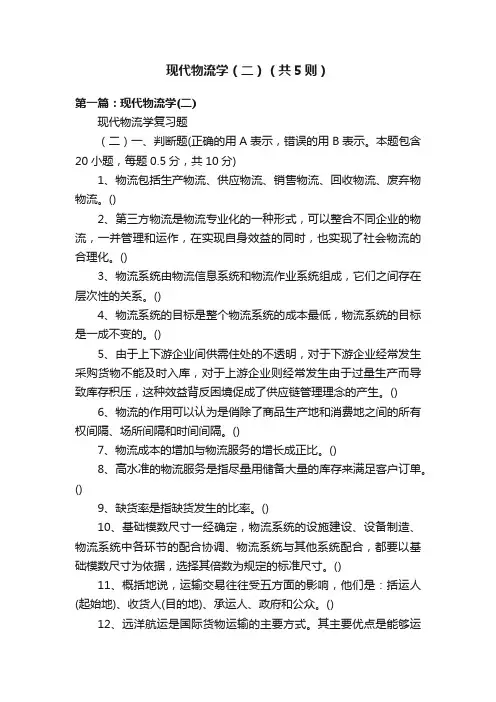
现代物流学(二)(共5则)第一篇:现代物流学(二)现代物流学复习题(二)一、判断题(正确的用A表示,错误的用B表示。
本题包含20小题,每题0.5分,共10分)1、物流包括生产物流、供应物流、销售物流、回收物流、废弃物物流。
()2、第三方物流是物流专业化的一种形式,可以整合不同企业的物流,一并管理和运作,在实现自身效益的同时,也实现了社会物流的合理化。
()3、物流系统由物流信息系统和物流作业系统组成,它们之间存在层次性的关系。
()4、物流系统的目标是整个物流系统的成本最低,物流系统的目标是一成不变的。
()5、由于上下游企业间供需住处的不透明,对于下游企业经常发生采购货物不能及时入库,对于上游企业则经常发生由于过量生产而导致库存积压,这种效益背反困境促成了供应链管理理念的产生。
()6、物流的作用可以认为是俏除了商品生产地和消费地之间的所有权间隔、场所间隔和时间间隔。
()7、物流成本的增加与物流服务的增长成正比。
()8、高水准的物流服务是指尽量用储备大量的库存来满足客户订单。
()9、缺货率是指缺货发生的比率。
()10、基础模数尺寸一经确定,物流系统的设施建设、设备制造、物流系统中各环节的配合协调、物流系统与其他系统配合,都要以基础模数尺寸为依据,选择其倍数为规定的标准尺寸。
()11、概括地说,运输交易往往受五方面的影响,他们是:括运人(起始地)、收货人(目的地)、承运人、政府和公众。
()12、远洋航运是国际货物运输的主要方式。
其主要优点是能够运输数量巨大的货物,适合于进行长距离、低价值、高密度、便于机械设备搬运的货物运输。
其营运范围不受限制,可靠性与可接近性较好。
()13、企业在做出有关仓库方面的决策时,一般都是从仓库维护成本和顾客服务水平这两方面来考虑,从而合理地使用公共仓库、自有仓库和合同仓库,达到在不降低顾客服务水平的情况下使成本最低。
()14、仓库一个最明显的功能就是保管产品,但随着人们对仓库概念的深入理解,仓库也担负着处理破损、集成管理和信息服务的功能,其涵义已经远远超出了单一的存储功能。
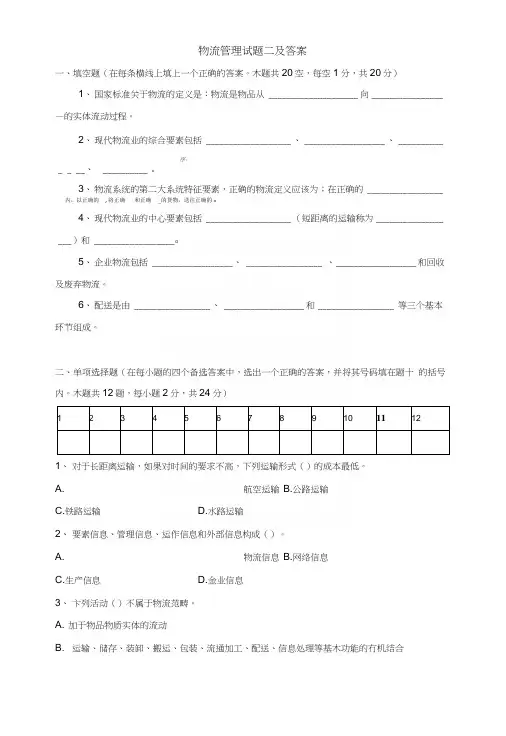
物流管理试题二及答案一、填空题(在每条横线上填上一个正确的答案。
木题共20空,每空1分,共20分)1、国家标准关于物流的定义是:物流是物品从 ____________________ 向________________ —的实体流动过程。
2、现代物流业的综合要素包括 ___________________ 、__________________ 、__________序-_ _ __ 、__________ o3、物流系统的第二大系统特征要素,正确的物流定义应该为;在正确的 _________________内,以正确的,将正确和正确 _的货物,送往正确的o4、现代物流业的中心要素包括 ___________________ (短距离的运输称为_______________ ___ )和 __________________ O5、企业物流包括 __________________ 、 _________________ 、__________________ 和回收及废弃物流。
6、配送是由 _________________ 、__________________ 和_________________ 等三个基本环节组成。
二、单项选择题(在每小题的四个备选答案中,选出一个正确的答案,并将其号码填在题十的括号内。
木题共12题,每小题2分,共24分)1234567891011121、对于长距离运输,如果对时间的要求不高,下列运输形式()的成本最低。
A. 航空运输B.公路运输C.铁路运输D.水路运输2、要素信息、管理信息、运作信息和外部信息构成()。
A. 物流信息B.网络信息C.生产信息D.金业信息3、卞列活动()不属于物流范畴。
A. 加于物品物质实体的流动B. 运输、储存、装卸、搬运、包装、流通加工、配送、信息处理等基木功能的冇机结合C. 商流所有权转移和物流的实体位置转移D. 不属于经济活动的物质实体流动4、国际运输中可以做到直达的有()oA.航空运输B.公路运输C.铁路运输D.海洋运输5、全球定位系统的英文缩写是()。
习题第一章一、判断题(正确的用A表示,错误的用B表示)1.商流和物流的关系非常密切,两者都具有相同的活动内容和规律。
( )2.物流活动克服了供给方和需求方在空间和时间方面的距离。
( )3.物流科学是管理科学和工程技术科学相结合的综合学科。
( )4.流通包含商流、物流、资金流和信息流,其中信息流从属于物流。
( )5.商流是产生物流的物质基础.( )6.流通活动中资金流是在所有权更迭的交易过程中发生的,可以认为从属于商流。
( ) 7.商流主要进行运输和储存,实现物资实体空间和时间位置转移,而物流过程主要进行商品交换,实现物资所有权的转移。
( )8.实行商物分离的原则是提高社会经济效益的客观需要,也是企业现代化发展的需要。
( ) 9.我国是从美国引进“物流”一词。
( )10.Logistics取代P.D,成为物流科学的代名词,这是物流科学走向成熟的标志。
( )11. 在铁路、公路、水运、航空等运输方式中,一般说来,我国货运量最大的是铁路。
( )12. 运输和配送长期以来被看成物流活动的两大支柱。
( )13. 仓储的目的是克服产品生产与消费在时间上的差异,使物资产生时间效果,实现其使用价值。
( )14. 装卸搬运过程中,活性化越高越好。
( )15. 包装可以看成是生产的终点,同时也是流通的起点。
( )16. 按包装功能分类可以把包装分为工业包装和商业包装。
( )17.根据物流活动发生的先后次序,企业物流可划分为供应物流、生产物流,销售物流、回收废弃物物流四部分。
()18.物流科学是以物的动态流转过程为主要研究对象,揭示了物流活动之间存在相互关联、相互制约的内在联系。
()19.产成品从生产者所有转变为用户所有的过程,同时也伴随着对象物从生产地转移到使用地以实现其使用价值的过程。
()20.提供第三方物流服务的企业,参与商品的买卖活动。
( )21.第三方物流在合约关系上是一种一对多的形式。
( )22.传统物流在服务功能上与第三方物流相比非常单一。
《现代物流学》同步强化练习(一)一、单项选择题1.物流的概念最早出现在( )A.美国 B.日本 C.中国 D.印度2.以下选项中,不属于现代物流的特征的是 ( )A.电子化 B.社会化C.专业化 D.集约化3.对物流活动或是相关的功能要素进行的管理称为( )A.物流战略管理 B.物流作业管理C.物流服务管理 D.供应链管理二、多项选择题1.物流系统的构成要素主要包括 ( BCDE )A.装卸搬运 B.物流设施 C.物流信息系统 D.人员 E.组织管理2.以下属于物流系统的特点的是( ABCE )A.目的性 B.整体性 C.协调性 D.客观性 E.专业性3.以下关于物流管理的发展阶段的描述中,正确的是( ACDE )A.物流管理的发展大致经历了五个阶段B.在物流功能个别管理阶段中,真正意义上的物流管理意识已经出现C.在物流管理领域扩大阶段中,物流合理化领域扩大到了生产和销售部门D.在物流功能的系统化管理阶段中,管理的对象是对物流过程中的各个功能进行最优组合E.目前物流管理的高级阶段是供应链物流管理阶段4.供应链管理是将与企业有业务关联的( ABCDE )等所有供应链上的企业和消费者作为一个整体来看待的系统结构。
A.供应商 B.制造商 C.批发商 D.零售商 E.顾客5.以下选项中,属于物流标准化的特点的是( BCE )A.整体性 B.复杂性 C.民主性 D.协调性 E.国际性三、名词解释1.物流:是指物品从供应地向接受地的实体流动过程。
是根据实际需要,将运输、储存、装卸、搬运、包装、流通加工、配送、信息处理等基本功能实施的有机结合。
2.物流系统:是指由两个或两个以上的物流功能单元构成的,以完成物流服务为目的的有机集合体。
3.物流管理:为了以最低的物流成本达到用户所满意的服务水平,对物流活动进行的计划、组织、协调与控制。
4.物流服务:是指物流企业(或是企业内部的物流部门)从处理客户订货开始,直到商品送交客户过程中所进行的全部活动。
PART IIIEXAMINATION QUESTIONSCHAPTER 1: LOGISTICS AND THE SUPPLY CHAINMultiple Choice Questions1.Logistics as a percentage of U.S. Gross Domestic Product is approximately (within 2%):a.5%b.10%c.15%d.20%e.none of the above(b; p. 4)2.Logistics clearly contributes to ___________ and ___________ utility.a.time; placeb.form; timec.place; formd.possession; timee.none of the above(a; p. 4)3.___________ utility refers to the value or usefulness that comes from a customer being able to take possession of a product.a.timeb.placec.formd.possession(d; p. 4)4.___________ utility refers to having products available where they are needed by customers.a.possessionb.timec.placed.form(c; p. 5).5.All of the following terms have been used to refer to business logistics except:a.business logisticsb.industrial distributionc.logistics managementd.physical distributione.all of the above are correct(e; p. 5)6.“How well a company does what it says it's going to do”represents ___________.a.efficiencyb.productivityc.leading edge logisticsd.effectiveness(d; p. 6)7.Every customer getting the same type and levels of logistics service refers to___________.a.tailored logisticsb.mass logisticsc.effectivenessd.efficiency(b; p. 7)8.Which of the following is not a reason for the increased importance of logistics?a.growing power of manufacturersb.reduction in economic regulationc.globalization of traded.technological advances(a; pp. 8–10)9.What logistics “outsider”developed the concept of the value chain?a.Donald Bowersoxb.Gus Pagonisc.Michael Porterd.Michael Hammer(c; p. 8).10.The ___________ approach indicates that a company's objectives can be realized byrecognizing the mutual interdependence of major functional areas.a.supply chainb.systemsc.interfunctionalityd.total cost(b; p. 10)11.The movement and storage of materials into a firm refers to:a.physical distributionb.materials managementc.materials handlingd.inbound logistics(d; p. 10)12.The movement and storage of materials within a firm refers to:a.physical distributionb.inbound logisticsc.materials managementd.procurement(c; p. 10)13.Logistics managers use the ___________ approach to coordinate inbound logistics,materials management, and physical distribution in a cost efficient manner.a.total costb.supply chainc.mass logisticsd.interfunctional(a; p. 11)14.A cost trade-off is a situation where:a.all costs react according to their individual degrees of inflation in the economyb.all costs are reflected as a percentage variation from standard costsc.some costs increase, some decrease, and the net effect is that total costs decreased.some costs are eliminated by efficient management controls(c; p. 13).15.The cash flow associated with holding inventory is known as inventory___________.a.turnoverb.valuationc.stockd.float(d; p. 14)16.__________ refers to one location where customers can purchase products from twoor more brand-name retailers.a.intensive distributionb.co-brandingc.co-generationd.selective distribution(b; p. 14)17.Phantom freight refers to:a.paying more for transportation than the actual costte shipmentsc.shipments accepted by non-certified carriersd.freight that “disappears”in transit(a; pp. 15–16)18.Freight absorption refers to:a.a special rate to cover increasing fuel costsb.rates that are higher than other carriers chargec.the ability of cardboard to absorb moistured.transportation payments lower than the actual costs incurred to ship the product(d; p. 16)nded costs refer to:a.a product that is shipped via surface transportb.a product that is quoted cost on delivery (COD)c.a prepaid shipmentd.a price that includes both the cost of the product plus transportation to the buyer(d; p. 15).20.___________ is the excess freight bill paid by customers who live near the shippingpoint.a.freight absorptionb.delivered pricec.phantom freightnded price(c; p. 15)21.In FOB origin pricing, all of the following are true except:a.prices quoted do not include transportation to the consigneeb.marketers can adopt uniform prices on a regional or national basisc.consignees must arrange for the transportation of the purchased productd.the seller always receives the same net from each sale(b; p. 15)22.___________ refers to a situation where the applicable charges are paid at the time ashipment is tendered to a carrier.a.freight prepaidb.freight absorptionc.phantom freightd.FOB origin(a; p. 16)23.___________ refers to charges being paid at the time of shipment delivery.a.freight absorptionb.freight yieldc.freight collectd.FOB destination(c; p. 16)24.The four basic components of the marketing mix include all of the following except:a.priceb.productionc.productd.place(b; p. 14).25.The most common interface between production and logistics generally involves:a.the use of plastic versus wood palletsb.the mode of transportationc.shipment pricingd.the length of production runs(d; p. 18)26.___________ refers to the delay of value-added activities such as assembly, production, and packaging to the latest possible time.a.building blocksb.deferralc.demurraged.postponement(d; p. 19)27.The ownership channel consists of all parties except:a.customersb.manufacturersc.wholesalersd.retailers(a; p. 19)28.The ____________ channel handles the physical flow of product.a.ownershipb.negotiationsc.logisticsd.promotions(c; p. 19)29.Which channel covers the movement of title to the goods?a.promotionsb.logisticsc.financed.ownership(d; p. 21).30.Which of the following is not part of the marketing channel?a.the logistics channelb.the negotiations channelc.the promotion channeld.the finance channele.all are part of the marketing channel(e; p. 19)31.Channel intermediaries:a.assume temporary ownership of the goodsb.fill nichesc.disappear as the market becomes organizedd.tend to lack focus(b; p. 24)32.Intermediaries in the marketing channel perform all of the following functions except:a.supply informationb.match buyers and sellersc.assume temporary ownership of the goodsd.develop and fill niches(c; pp. 23–24)33.The most costly logistics activity in many firms is ____________.a.industrial packagingb.warehousing managementc.order managementd.transportation management(d; p. 27)34.____________ is bringing together similar stocks from different sources.a.accumulatingb.assortingc.auditingd.allocating(a; p. 23).35.____________ refers to breaking a homogenous supply into smaller lots.a.sorting outb.allocatingc.accumulatingd.assorting(b; p. 23)True-False Questions1.Absolute and relative logistics costs in relation to Gross Domestic Product vary fromcountry to country. (True; p. 4)2.Logistics clearly contributes to time and form utility. (False; p. 4)3.The current definition of logistics, as promulgated by the Council of Logistics Management, suggests that logistics is part of the supply chain process. (True; p. 6)4.The purpose of logistics is to maximize customer service. (False; p. 7)5.Logistical principles apply only to for-profit organizations. (False; p. 7)6.Two of the five primary activities in the value chain are inbound logistics and outbound logistics. (True; pp. 8–9)7.The key aspect of the total cost approach is to maximize customer satisfaction. (False;p. 13)8.The Internet has done little to improve logistical effectiveness and efficiency. (False;p. 9)9.Stock-keeping units (SKUs) are the same as line items of inventory. (True; p.10)10.Inbound logistics refers to the movement and storage of materials into a firm. (True; p.10)11.Inbound logistics is synonymous with materials management. (False; p. 10)12.Interfunctional logistics attempts to coordinate inbound logistics, materials manage-ment, and physical distribution in a cost efficient manner that supports an organization's customer service objectives. (False; p. 10)mon sense is one of the keys to being an effective logistics manager. (True; p.11).14.The key to the total cost approach is that all relevant cost items are considered simultaneously when making a decision. (True; p. 13)15.Logistics offers many companies an important route for creating marketing superiority. (True; p.14)16.Co-branding is a retailing strategy that is associated with place decisions. (True; p.14)17.As a general rule, marketers prefer FOB origin pricing rather than FOB destinationpricing. (False; pp. 15–16)18.Phantom freight and freight absorption are associated with FOB origin pricing. (False;pp. 15–16)19.It is better for a logistics manager to be a generalist rather than a specialist. (False; p.27)20.Stockouts refer to a situation where a company is out of an item at the same time thatthere is demand for that item. (True; p. 18)21.Long production runs sometimes result in excessive inventory of products with limited demand for them. (True; p. 18)22.Intermediaries assume ownership of goods while they're in the marketing channel. (False; p. 24)23.Channel members are usually more concerned about sellers' needs than with buyers'needs. (False; p. 20)24.The negotiations channel is the one where buy and sell agreements are reached. (True;p. 21)25.There is no linkage between the promotions and logistics channel. (False; pp.22–23)26.The most significant contribution that the logistics channel makes to the overall channel process is the sorting function. (True; p. 23)27.The sorting function has four steps. (True; p. 23)28.The sorting function takes place between retailers and the consumer. (False; p. 23)29.A broker is a type of intermediary often associated with the negotiations channel. (True; p 24.)30.In channel negotiations, all parties are presumed to have equal bargaining strength.(False; pp. 20-21).31.Freight forwarders are the most common intermediary in the logistics channel. (True;p. 24)32.Returned products represent one type of activity in the logistical channel. (True; p.27)33.The key to total cost analysis is to make sure that either transportation or inventorycosts are minimized. (False; p. 13)34.There are relatively few opportunities for employment in the logistics sector. (False; p.27)35.The logistics channel is the most important of the marketing channels. (False; p.19).。
PART IIANSWERS TO END-OF-CHAPTER QUESTIONSCHAPTER 1: LOGISTICS AND THE SUPPLY CHAIN1. Did it surprise you that logistics can be such an important component in a country’s economic system? Why or why not?The answer to this question likely depe nds on a student’s prior exposure to logistics. A “typical” student in an undergraduate basic logistics course likely has had limited exposure to,and knowledge about, logistics and thus would likely be unaware as to logistics’ impact on acountry’s econom ic system. As such, she/he might be pleasantly surprised to learn that logistics often accounts for at least 10% of a country’s GDP and also is important for economic growthand development.2.Distinguish between possession, form, time, and place utility.Possession utility refers to the value or usefulness that comes from a customer being able to take possession of a product and can be influenced by the relevant payment terms. Form utility refers to a product’s being in a form that (1) can be used by the c ustomer and (2) is of value to the customer. Place utility refers to having products available where they are needed bycustomers, while time utility refers to having products available when they are needed bycustomers.3.How does logistics contribute to time and place utility?Logistics contributes to time utility by recognizing that different products have different sensitivities to time. For example, a three-day late delivery of bananas likely has more seriousconsequences than a three-day late delivery of a box of pencils. As for place utility, logisticsfacilitates products being moved from points of lesser value to points of greater value.4.How can a particular logistics system be effective but not efficient?Effectiveness can be thought of as “how well a company does what they say they’re going to do;” efficiency focuses on how well (or poorly) company resources are used to achieve what acompany promises they can do. There are a multitude of examples that would illustrate aneffective, but not efficient, logistics system. For example, some companies routinely usepremium and/or expedited transportation—which increase transportation costs—to meetcustomer delivery requirements. As such, the company could be considered effective (meeting delivery deadlines) but perhaps not efficient (increased transportation costs).5.Does the fact that information can be substituted for inventory decrease or increase the difficulty of logistics management? Support your response.There is not necessarily a “right” or “wrong” answer to this question. On the one hand, substituting information for inventory could decrease the difficulty of logistics management in the sense that decision making can be based on more objective, rather than subjective, data. On the other hand, the difficulty of logistics management could be increased because the ability to exactly match supply and demand places greater emphasis on correctly filling and delivering orders.6.Explain the significance of the fact that the purpose of logistics is to meet customer requirements.One reason for this significance is that meeting customer requirements means that companies must know—rather than assume—customer needs and wants. This knowledge is facilitated by communication between companies and their customers; even today somecompanies are hesitant to communicate with customers. In addition, meeting customerrequirements means that a “one size fits all” approach to logistics will result in some customers being overserved and others being underserved. As a result, companies should consider a“tailored logistics” approach, where groups of customers with similar logistical needs and wants are provided with the appropriate logistical services.7.Explain how an understanding of logistics management could be relevant to your favorite charitable organization.There are any number of examples that can be used. Consider how the American Red Cross responded to the terrorist attacks of September 11, 2001. In a relatively short time, the Red Cross, with private sector support, was able to collect, assemble, warehouse, transport, and distribute relief supplies such as boots, safety goggles, and protective clothing, to New York City.8.Discuss three reasons for why logistics has become more important since 1980.One reason for the increased importance of logistics involves a reduction in economic regulation. This allowed individual carriers flexibility in terms of pricing and service and provided them an opportunity to break away from a “one size fits all” approach. Second, logistics has been championed by prominent non-logisticians; one important outcome has been recognition that logistics can be a source of competitive advantage for individual organizations. Third,technological advances have allowed logisticians to make faster, more informed, and more accurate decisions. The chapter also discusses the growing power of retailers and globalization of trade as reasons for the increased importance of logistics.9.Which reason for the increased importance of logistics do you believe is most important? Why?There is no single answer here. Students can offer compelling support for any one of the five reasons—a reduction in economic regulation; recognition by prominent non-logisticians;technological advances; growing power of retailers; globalization of trade—presented in the chapter. For example, a reduction in economic regulation has allowed carriers to offer different pricing-service options to different customers, which is important because different customers are trying to achieve different objectives with their logistical systems.10.What are some practical implications of the idea that one logistics system does not fit all companies?The idea that one logistics system does not fit all companies is derived from the fact that logistical goals and objectives should be compatible with the overall goals and objectives of a particular company. One basic implication is that different companies should have different logistical strategies and tactics—and these strategies and tactics should reflect company goals and objectives. As such, a company focusing on cost containment should have different logistics strategies and tactics than a company focusing on superior customer service. For instance, a company concerned with cost containment might purchase in extremely large quantities in order to receive cost savings. This decision impacts warehousing and transportation in the sense that the company will likely need a great deal of storage space and will likely utilize volume-oriented transportation providers. Additional implications can be offered.11.Distinguish between inbound logistics, materials management, and physical distribution.Inbound logistics refers to the movement and storage of materials into a firm; materials management refers to the movement and storage of materials and components within a firm;physical distribution refers to the storage of finished product and movement to the customer.12.What is the systems approach to problem solving? How is this concept applicable to logistics management?The systems approach to problem solving suggests that a company’s objectives can be realized by recognizing the mutual interdependence of the major functional areas such asmarketing, production, finance, and logistics. As such, decisions made by one functional area can have important implications for the other functional areas. With respect to logistics, the systems approach suggests that one should recognize the mutual interdependence of the variousactivities that constitute the logistics function. Thus, a transportation decision may impactinventory, warehousing, and packaging, among others.13.Explain what is meant by the total cost approach to logistics.The total cost approach to logistics is built on the premise that all relevant activities in moving and storing products should be considered as a whole (i.e., their total cost), and not individually. Use of the total cost approach requires an understanding of cost tradeoffs; in other words, changes to one logistics activity cause some costs to increase and others to decrease. The key to the total cost approach is that all relevant cost items are considered simultaneously when making a decision. The objective is to find the approach with the lowest total cost that supports the organization’s customer service requirements.14.Define what is meant by a cost trade-off. Do you believe that this concept is workable? Why or why not?A cost trade-off acknowledges that changing patterns or activities of distribution will resultin some costs increasing and other costs decreasing. The net effect, however, should be anoverall cost decrease for providing a given level of customer service.The remainder of the question asks the student for her/his opinion about the workability of this concept. Although nearly any answer is acceptable, those students who believe that cost trade-offs are unworkable might have difficulty with many of the concepts presented throughout the text.15.What are several areas in which finance and logistics might interface?The finance department is often in charge of capital budgeting decisions that would affect logistics, such as the materials handling and packaging equipment. Another potential area of finance/logistics interface is with respect to inventory. Key issues include inventory valuation, inventory float, and the fact that finance tends to view inventory from a dollar perspective while logistics tends to be more concerned with the number of units of inventory.16.Briefly discuss each of the four basic aspects of the marketing mix and how each interfaces with the logistics function. In your opinion, which component of the marketing mix represents the most important interface with logistics? Why?The four basic aspects of the marketing mix are place, price, product, and promotion. With respect to place, a key concern is to provide a certain product at the right time, in the rightquantities, and in an undamaged condition. A key component of the pricing decision involves transportation cost factors. Although marketers tend to prefer delivered pricing systems, such systems create logistical challenges in the sense that the seller becomes responsible for product distribution. Product decisions have been complicated in recent years by product proliferation;although this proliferation allows for greater customer choice, it creates logistical challenges in terms of identification, storage, and tracking. Finally, promotion requires close coordination between marketing and logistics, particularly when “specials” are utilized. Failure to havesufficient product availability to support these specials can be especially detrimental to customer goodwill.The remainder of the question asks for students to choose, and support, the most important interface with logistics. Any of the four components is acceptable.17.Why do marketers tend to prefer FOB destination pricing rather than FOB origin pricing?There are several reasons why marketers like FOB destination pricing. First, it enables a company to expand the geographic area to which its product is sold because distant customers ina region do not pay the full costs of transportation. Second, because each buyer has the samelanded cost, it is easier for a company to apply a uniform retail price on a regional or national basis. Third, because the seller controls the logistics network, it can function in a manner that is most beneficial to the seller’s overall objectives.18.What are several ways in which logistics and production might interface?One important interface involves the length of production runs. Production often favors longer production runs in order to achieve lower production costs per unit; however, thisgenerates large amounts of inventory—generally the responsibility of logistics. Another interface might occur with respect to the postponement concept in the sense that some value-added activities that were traditionally performed at the production plant are now performed inwarehousing facilities. These facilities will need new types of equipment and may need to be configured differently in order to allow the value-added activities to take place.19.Discuss five activities that might be part of a company’s logistics department.The chapter presents, and describes, 14 separate activities that might be part of a company’s logistics de partment. Any five of the 14 are acceptable to be discussed by thestudents.20.Logistics managers must be both generalists and specialists. Why is this true? Does this help to explain why there tends to be an imbalance in the supply of, and demand for, logistics managers?Logisticians need to be generalists in order to understand the relationship between logistics and other corporate functions, both within and outside the firm. Logisticians also need to be specialists to understand the relationships between various logistics activities, as well as having some technical knowledge of the various activities. This combination of generalist and specialist likely provides a partial explanation for the imbalance in the supply of, and demand for,logisticians in the sense that not everyone is capable of balancing generalist and specialistrequirements.PART IIIEXAMINATION QUESTIONSCHAPTER 1: LOGISTICS AND THE SUPPLY CHAINMultiple Choice Questions1.Logistics as a percentage of U.S. Gross Domestic Product is approximately (within 2%):a.5%b.10%c.15%d.20%e.none of the above(b; p. 4)2.Logistics clearly contributes to ___________ and ___________ utility.a.time; placeb.form; timec.place; formd.possession; timee.none of the above(a; p. 4)3.___________ utility refers to the value or usefulness that comes from a customer being able to take possession of a product.a.timeb.placec.formd.possession(d; p. 4)4.___________ utility refers to having products available where they are needed by customers.a.possessionb.timec.placed.form(c; p. 5)5.All of the following terms have been used to refer to business logistics except:a.business logisticsb.industrial distributionc.logistics managementd.physical distributione.all of the above are correct(e; p. 5)6.“How well a company does what it says it’s going to do” represents ___________.a.efficiencyb.productivityc.leading edge logisticsd.effectiveness(d; p. 6)7.Every customer getting the same type and levels of logistics service refers to___________.a.tailored logisticsb.mass logisticsc.effectivenessd.efficiency(b; p. 7)8.Which of the following is not a reason for the increased importance of logistics?a.growing power of manufacturersb.reduction in economic regulationc.globalization of traded.technological advances(a; pp. 8–10)9.What logistics “outsider” develo ped the concept of the value chain?a.Donald Bowersoxb.Gus Pagonisc.Michael Porterd.Michael Hammer(c; p. 8)10.The ___________ approach indicates that a company’s objectives can be realized by recognizing the mutual interdependence of major functional areas.a.supply chainb.systemsc.interfunctionalityd.total cost(b; p. 10)11.The movement and storage of materials into a firm refers to:a.physical distributionb.materials managementc.materials handlingd.inbound logistics(d; p. 10)12.The movement and storage of materials within a firm refers to:a.physical distributionb.inbound logisticsc.materials managementd.procurement(c; p. 10)13.Logistics managers use the ___________ approach to coordinate inbound logistics, materials management, and physical distribution in a cost efficient manner.a.total costb.supply chainc.mass logisticsd.interfunctional(a; p. 11)14. A cost trade-off is a situation where:a.all costs react according to their individual degrees of inflation in the economyb.all costs are reflected as a percentage variation from standard costsc.some costs increase, some decrease, and the net effect is that total costs decreased.some costs are eliminated by efficient management controls(c; p. 13)15.The cash flow associated with holding inventory is known as inventory ___________.a.turnoverb.valuationc.stockd.float(d; p. 14)16.__________ refers to one location where customers can purchase products from two or more brand-name retailers.a.intensive distributionb.co-brandingc.co-generationd.selective distribution(b; p. 14)17.Phantom freight refers to:a.paying more for transportation than the actual costte shipmentsc.shipments accepted by non-certified carriersd.freight that “disappears” in transit(a; pp. 15–16)18.Freight absorption refers to:a. a special rate to cover increasing fuel costsb.rates that are higher than other carriers chargec.the ability of cardboard to absorb moistured.transportation payments lower than the actual costs incurred to ship the product(d; p. 16)nded costs refer to:a. a product that is shipped via surface transportb. a product that is quoted cost on delivery (COD)c. a prepaid shipmentd. a price that includes both the cost of the product plus transportation to the buyer(d; p. 15)20.___________ is the excess freight bill paid by customers who live near the shipping point.a.freight absorptionb.delivered pricec.phantom freightnded price(c; p. 15)21.In FOB origin pricing, all of the following are true except:a.prices quoted do not include transportation to the consigneeb.marketers can adopt uniform prices on a regional or national basisc.consignees must arrange for the transportation of the purchased productd.the seller always receives the same net from each sale(b; p. 15)22.___________ refers to a situation where the applicable charges are paid at the time a shipment is tendered to a carrier.a.freight prepaidb.freight absorptionc.phantom freightd.FOB origin(a; p. 16)23.___________ refers to charges being paid at the time of shipment delivery.a.freight absorptionb.freight yieldc.freight collectd.FOB destination(c; p. 16)24.The four basic components of the marketing mix include all of the following except:a.priceb.productionc.productd.place(b; p. 14)25.The most common interface between production and logistics generally involves:a.the use of plastic versus wood palletsb.the mode of transportationc.shipment pricingd.the length of production runs(d; p. 18)26.___________ refers to the delay of value-added activities such as assembly, production, and packaging to the latest possible time.a.building blocksb.deferralc.demurraged.postponement(d; p. 19)27.The ownership channel consists of all parties except:a.customersb.manufacturersc.wholesalersd.retailers(a; p. 19)28.The ____________ channel handles the physical flow of product.a.ownershipb.negotiationsc.logisticsd.promotions(c; p. 19)29.Which channel covers the movement of title to the goods?a.promotionsb.logisticsc.financed.ownership(d; p. 21)30.Which of the following is not part of the marketing channel?a.the logistics channelb.the negotiations channelc.the promotion channeld.the finance channele.all are part of the marketing channel(e; p. 19)31.Channel intermediaries:a.assume temporary ownership of the goodsb.fill nichesc.disappear as the market becomes organizedd.tend to lack focus(b; p. 24)32.Intermediaries in the marketing channel perform all of the following functions except:a.supply informationb.match buyers and sellersc.assume temporary ownership of the goodsd.develop and fill niches(c; pp. 23–24)33.The most costly logistics activity in many firms is ____________.a.industrial packagingb.warehousing managementc.order managementd.transportation management(d; p. 27)34.____________ is bringing together similar stocks from different sources.a.accumulatingb.assortingc.auditingd.allocating(a; p. 23)35.____________ refers to breaking a homogenous supply into smaller lots.a.sorting outb.allocatingc.accumulatingd.assorting(b; p. 23)True-False Questions1.Absolute and relative logistics costs in relation to Gross Domestic Product vary from country to country. (True; p. 4)2.Logistics clearly contributes to time and form utility. (False; p. 4)3.The current definition of logistics, as promulgated by the Council of Logistics Management, suggests that logistics is part of the supply chain process. (True; p. 6)4.The purpose of logistics is to maximize customer service. (False; p. 7)5.Logistical principles apply only to for-profit organizations. (False; p. 7)6.Two of the five primary activities in the value chain are inbound logistics and outbound logistics. (True; pp. 8–9)7.The key aspect of the total cost approach is to maximize customer satisfaction. (False; p.13)8.The Internet has done little to improve logistical effectiveness and efficiency. (False; p. 9)9.Stock-keeping units (SKUs) are the same as line items of inventory. (True; p.10)10.Inbound logistics refers to the movement and storage of materials into a firm. (True; p. 10)11.Inbound logistics is synonymous with materials management. (False; p. 10)12.Interfunctional logistics attempts to coordinate inbound logistics, materials management, and physical distribution in a cost efficient manne r that supports an organization’s customer service objectives. (False; p. 10)mon sense is one of the keys to being an effective logistics manager. (True; p. 11)14.The key to the total cost approach is that all relevant cost items are considered simultaneously when making a decision. (True; p. 13)15.Logistics offers many companies an important route for creating marketing superiority. (True; p.14)16.Co-branding is a retailing strategy that is associated with place decisions. (True; p. 14)17.As a general rule, marketers prefer FOB origin pricing rather than FOB destination pricing. (False; pp. 15–16)18.Phantom freight and freight absorption are associated with FOB origin pricing. (False; pp. 15–16)19.It is better for a logistics manager to be a generalist rather than a specialist. (False; p. 27)20.Stockouts refer to a situation where a company is out of an item at the same time that there is demand for that item. (True; p. 18)21.Long production runs sometimes result in excessive inventory of products with limited demand for them. (True; p. 18)22.Intermediaries assume ownership of goods while they’re in the marketing channel. (False; p. 24)23.Channel members are usually more concerned about sellers’ needs than with buyers’ needs. (False; p. 20)24.The negotiations channel is the one where buy and sell agreements are reached. (True; p.21)25.There is no linkage between the promotions and logistics channel. (False; pp. 22–23)26.The most significant contribution that the logistics channel makes to the overall channel process is the sorting function. (True; p. 23)27.The sorting function has four steps. (True; p. 23)28.The sorting function takes place between retailers and the consumer. (False; p. 23)29. A broker is a type of intermediary often associated with the negotiations channel. (True; p 24.)30.In channel negotiations, all parties are presumed to have equal bargaining strength. (False; pp. 20-21)31.Freight forwarders are the most common intermediary in the logistics channel. (True; p.24)32.Returned products represent one type of activity in the logistical channel. (True; p. 27)33.The key to total cost analysis is to make sure that either transportation or inventory costs are minimized. (False; p. 13)34.There are relatively few opportunities for employment in the logistics sector. (False; p. 27)35.The logistics channel is the most important of the marketing channels. (False; p. 19) PART IVCASE SOLUTIONSCases are included at the end of each chapter. They vary in length, difficulty, and type of problem addressed, and some students may find them to be difficult. All of these cases have been pre-tested in one or more classes. The answers given here are based on what were considered to be “complete” (although not exhaustively thorough) student responses.Instructors should develop their own techniques for using the cases. Many can serve as the basis for detailed, and lengthy, classroom discussions. Many of the cases can be used for examination purposes, although many of the questions have more than one single correct answer.Prev ious adopters of our text have wondered about an “ideal” length for written answers to the various case questions. We hesitate to offer such guidance, in part because the “ideal” length depends on a variety of factors. For example, if the written answers a re a type of “extra credit” that can be earned, then shorter answers are likely preferable to longer ones. Alternatively, if the cases are used for examination purposes, then longer answers might be preferable to shorter ones.Several of the cases can be analyzed using commonly-used software packages such as Excel, and we suggest that the instructor familiarize themselves with the software and its application to the relevant case—PRIOR to assigning the case. Such instructor preparation is important and necessary because today’s college student is far more computer literate than in the past.Cases must be carefully read because key facts may be hidden. Instructors should clearly indicate how much additional data, not in the text of the original case, could be incorporated into each case analysis and its answers. For instance, a student who has worked in a warehouse may attempt to reference her or his own experiences in related situations.Answers for each question are included in this section of the manual. Where alternative answers are acceptable, they are indicated. Finally, a few discussion points the instructor might raise are included for some cases.CASE 1-1 SUDSY SOAP, INC.Question 1:Assume that you are Frank Johnson’s assistant, and he asks you to look into various scheduling problems that might occur. List and discuss them.First, extra time will be needed to put the dishes in the packages. How will this affect production schedules? How must production and delivery be altered to ensure that allgeographic markets, including Hawaii (if it is to be included in the TV campaign), receive thesame dish items in the same week? In addition, will packages have special printing that tell what type of dish they contain? If so, there will be problems coordinating the same dishes with thesame packages.Question 2: What packaging problems, if any, might there be?Will one package hold all five dishes, or will some require a unique package size (which will rule out the proposal)? What external changes in printing on the package will be needed? Willthe packages safely transport the dishes? Will the changed weight of packages have an impact on handling, or on transportation costs?Question 3: Many firms selling consumer goods are concerned with problems of product liability. Does the dish offer present any such problems? If so, what are they? Can they be accommodated?。
PART IIIEXAMINATION QUESTIONSCHAPTER 1: LOGISTICS AND THE SUPPLY CHAINMultiple Choice Questions1.Logistics as a percentage of U.S. Gross Domestic Product is approximately (within2%):a.5%b.10%c.15%d.20%e.none of the above(b; p. 4)2.Logistics clearly contributes to ___________ and ___________ utility.a.time; placeb.form; timec.place; formd.possession; timee.none of the above(a; p. 4)3.___________ utility refers to the value or usefulness that comes from a customerbeing able to take possession of a product.a.timeb.placec.formd.possession(d; p. 4)4.___________ utility refers to having products available where they are needed bycustomers.a.possessionb.timec.placed.form(c; p. 5)5.All of the following terms have been used to refer to business logistics except:a.business logisticsb.industrial distributionc.logistics managementd.physical distributione.all of the above are correct(e; p. 5)6.“How well a company does what it says it’s going to do” represents ___________.a.efficiencyb.productivityc.leading edge logisticsd.effectiveness(d; p. 6)7.Every customer getting the same type and levels of logistics service refers to___________.a.tailored logisticsb.mass logisticsc.effectivenessd.efficiency(b; p. 7)8.Which of the following is not a reason for the increased importance of logistics?a.growing power of manufacturersb.reduction in economic regulationc.globalization of traded.technological advances(a; pp. 8–10)9.What logistics “outsider” developed the concept of the value chain?a.Donald Bowersoxb.Gus Pagonisc.Michael Porterd.Michael Hammer(c; p. 8)10.The ___________ approach indicates that a company’s objectives can be realized byrecognizing the mutual interdependence of major functional areas.a.supply chainb.systemsc.interfunctionalityd.total cost(b; p. 10)11.The movement and storage of materials into a firm refers to:a.physical distributionb.materials managementc.materials handlingd.inbound logistics(d; p. 10)12.The movement and storage of materials within a firm refers to:a.physical distributionb.inbound logisticsc.materials managementd.procurement(c; p. 10)13.Logistics managers use the ___________ approach to coordinate inbound logistics,materials management, and physical distribution in a cost efficient manner.a.total costb.supply chainc.mass logisticsd.interfunctional(a; p. 11)14.A cost trade-off is a situation where:a.all costs react according to their individual degrees of inflation in the economyb.all costs are reflected as a percentage variation from standard costsc.some costs increase, some decrease, and the net effect is that total costsdecreased.some costs are eliminated by efficient management controls(c; p. 13)15.The cash flow associated with holding inventory is known as inventory ___________.a.turnoverb.valuationc.stockd.float(d; p. 14)16.__________ refers to one location where customers can purchase products from twoor more brand-name retailers.a.intensive distributionb.co-brandingc.co-generationd.selective distribution(b; p. 14)17.Phantom freight refers to:a.paying more for transportation than the actual costte shipmentsc.shipments accepted by non-certified carriersd.freight that “disappears” in transit(a; pp. 15–16)18.Freight absorption refers to:a. a special rate to cover increasing fuel costsb.rates that are higher than other carriers chargec.the ability of cardboard to absorb moistured.transportation payments lower than the actual costs incurred to ship theproduct(d; p. 16)nded costs refer to:a. a product that is shipped via surface transportb. a product that is quoted cost on delivery (COD)c. a prepaid shipmentd. a price that includes both the cost of the product plus transportation to thebuyer(d; p. 15)20.___________ is the excess freight bill paid by customers who live near the shippingpoint.a.freight absorptionb.delivered pricec.phantom freightnded price(c; p. 15)21.In FOB origin pricing, all of the following are true except:a.prices quoted do not include transportation to the consigneeb.marketers can adopt uniform prices on a regional or national basisc.consignees must arrange for the transportation of the purchased productd.the seller always receives the same net from each sale(b; p. 15)22.___________ refers to a situation where the applicable charges are paid at the time ashipment is tendered to a carrier.a.freight prepaidb.freight absorptionc.phantom freightd.FOB origin(a; p. 16)23.___________ refers to charges being paid at the time of shipment delivery.a.freight absorptionb.freight yieldc.freight collectd.FOB destination(c; p. 16)24.The four basic components of the marketing mix include all of the following except:a.priceb.productionc.productd.place(b; p. 14)25.The most common interface between production and logistics generally involves:a.the use of plastic versus wood palletsb.the mode of transportationc.shipment pricingd.the length of production runs(d; p. 18)26.___________ refers to the delay of value-added activities such as assembly,production, and packaging to the latest possible time.a.building blocksb.deferralc.demurraged.postponement(d; p. 19)27.The ownership channel consists of all parties except:a.customersb.manufacturersc.wholesalersd.retailers(a; p. 19)28.The ____________ channel handles the physical flow of product.a.ownershipb.negotiationsc.logisticsd.promotions(c; p. 19)29.Which channel covers the movement of title to the goods?a.promotionsb.logisticsc.financed.ownership(d; p. 21)30.Which of the following is not part of the marketing channel?a.the logistics channelb.the negotiations channelc.the promotion channeld.the finance channele.all are part of the marketing channel(e; p. 19)31.Channel intermediaries:a.assume temporary ownership of the goodsb.fill nichesc.disappear as the market becomes organizedd.tend to lack focus(b; p. 24)32.Intermediaries in the marketing channel perform all of the following functions except:a.supply informationb.match buyers and sellersc.assume temporary ownership of the goodsd.develop and fill niches(c; pp. 23–24)33.The most costly logistics activity in many firms is ____________.a.industrial packagingb.warehousing managementc.order managementd.transportation management(d; p. 27)34.____________ is bringing together similar stocks from different sources.a.accumulatingb.assortingc.auditingd.allocating(a; p. 23)35.____________ refers to breaking a homogenous supply into smaller lots.a.sorting outb.allocatingc.accumulatingd.assorting(b; p. 23)True-False Questions1.Absolute and relative logistics costs in relation to Gross Domestic Product vary fromcountry to country. (True; p. 4)2.Logistics clearly contributes to time and form utility. (False; p. 4)3.The current definition of logistics, as promulgated by the Council of LogisticsManagement, suggests that logistics is part of the supply chain process. (True; p. 6)4.The purpose of logistics is to maximize customer service. (False; p. 7)5.Logistical principles apply only to for-profit organizations. (False; p. 7)6.Two of the five primary activities in the value chain are inbound logistics andoutbound logistics. (True; pp. 8–9)7.The key aspect of the total cost approach is to maximize customer satisfaction. (False;p. 13)8.The Internet has done little to improve logistical effectiveness and efficiency. (False;p. 9)9.Stock-keeping units (SKUs) are the same as line items of inventory. (True; p.10)10.Inbound logistics refers to the movement and storage of materials into a firm. (True; p.10)11.Inbound logistics is synonymous with materials management. (False; p. 10)12.Interfunctional logistics attempts to coordinate inbound logistics, materials manage-ment, and physical distribution in a cost efficient manner that supports anorganization’s customer service objectives. (False; p. 10)mon sense is one of the keys to being an effective logistics manager. (True; p.11)14.The key to the total cost approach is that all relevant cost items are consideredsimultaneously when making a decision. (True; p. 13)15.Logistics offers many companies an important route for creating marketingsuperiority. (True; p.14)16.Co-branding is a retailing strategy that is associated with place decisions. (True; p. 14)17.As a general rule, marketers prefer FOB origin pricing rather than FOB destinationpricing. (False; pp. 15–16)18.Phantom freight and freight absorption are associated with FOB origin pricing. (False;pp. 15–16)19.It is better for a logistics manager to be a generalist rather than a specialist. (False; p.27)20.Stockouts refer to a situation where a company is out of an item at the same time thatthere is demand for that item. (True; p. 18)21.Long production runs sometimes result in excessive inventory of products withlimited demand for them. (True; p. 18)22.Intermediaries assume ownership of goods while the y’re in the marketing channel.(False; p. 24)23.Channel members are usually more concerned about sellers’ needs than with buyers’needs. (False; p. 20)24.The negotiations channel is the one where buy and sell agreements are reached. (True;p. 21)25.There is no linkage between the promotions and logistics channel. (False; pp. 22–23)26.The most significant contribution that the logistics channel makes to the overallchannel process is the sorting function. (True; p. 23)27.The sorting function has four steps. (True; p. 23)28.The sorting function takes place between retailers and the consumer. (False; p. 23)29.A broker is a type of intermediary often associated with the negotiations channel.(True; p 24.)30.In channel negotiations, all parties are presumed to have equal bargaining strength.(False; pp. 20-21)31.Freight forwarders are the most common intermediary in the logistics channel. (True;p. 24)32.Returned products represent one type of activity in the logistical channel. (True; p. 27)33.The key to total cost analysis is to make sure that either transportation or inventorycosts are minimized. (False; p. 13)34.There are relatively few opportunities for employment in the logistics sector. (False; p.27)35.The logistics channel is the most important of the marketing channels. (False; p. 19)。